The role of team leader in recruiting
We know how often the communication of potential candidates with HR is perceived with hostility. That is why, when you yourself are looking for new cool employees, you cannot shift all your worries to someone else and hope that you will be brought a rock star on a silver platter.
For hiring is almost fatal if the timlid withdraws from the process. Your personal history can sell a job as easily to a candidate as no HR brand can. Under the conditions of shortage of personnel, the role of the team leader in recruiting is one of the leading ones.

The report of Katerina Gavrilova on Saint TeamLead Conf gives quite specific, not too time-consuming recommendations for managers who want to hire their people into their team and not spend half a year searching.
About the speaker: Katerina Gavrilova ( katerinadhr ) has been in recruitment for many years, since 2011 she has been the founder and head of the recruitment agency DigitalHR, which deals exclusively with the search for Digital and IT specialists.
Mostly we work with small teams, in which most often there is no HR of their own. This experience shows that a team leader plays a key role in hiring new employees, and a lot depends on how the interview goes, how he invites a person. This will be the focus of today's story, and not on interaction with HR or external recruiters.
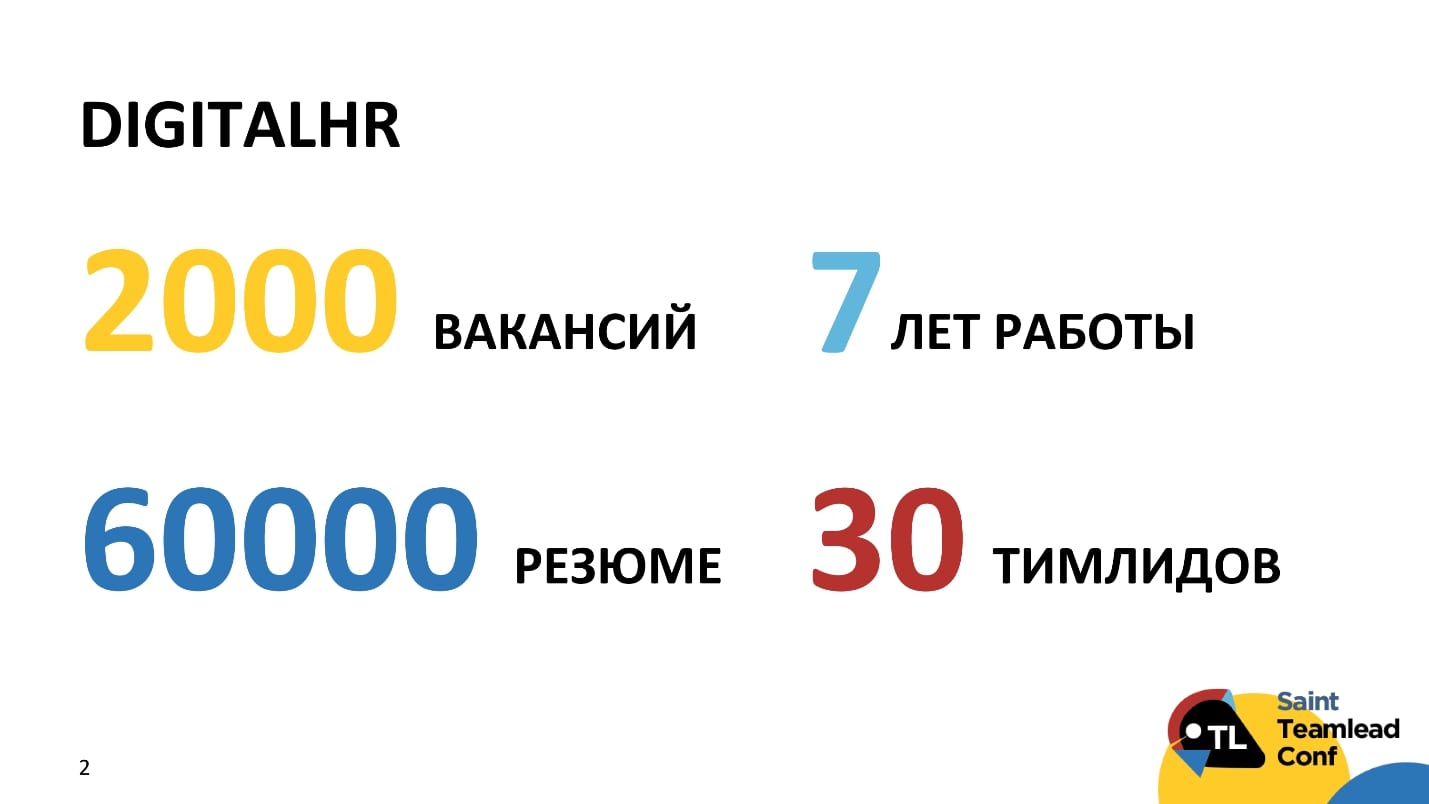
Most of all I support small teams that are really hard to find someone. I will not talk about companies that receive 100 vacancy responses and can carry out all the most difficult stages of hiring, for example, as Facebook or Google does. This is all cool, but very far from the real world.
The hiring process usually begins with the fact that the timlid thinks that now he will make a cool job description, post it, get a lot of feedback and choose.
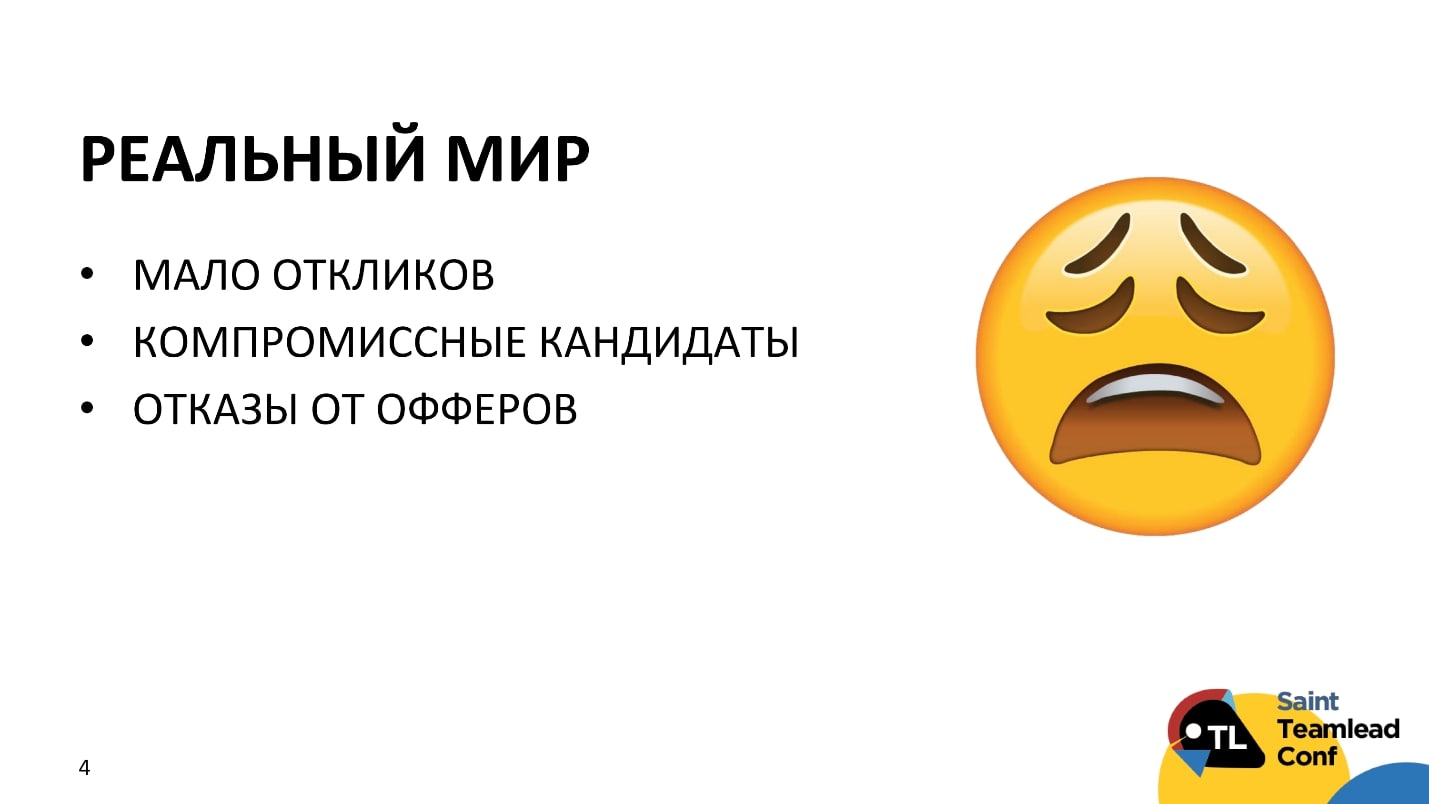
We think that we will close the vacancy in 2 weeks, or at least in a month. But in fact, either we do not receive any feedback at all, or from very compromise candidates. Probably every third team leader with whom we work says: “In general, everything is fine, but I don’t want to hire him, because the cost of a mistake is extremely high.” Plus rejection of offers. There are objective reasons for this.

One of them - 120% growth of vacancies in IT. If earlier there was a boom of startups, for example, in e-commerce 10 candidates responded to a vacancy, now there are no more than 3-4 responses. This 120% growth is provided not only by large IT-companies that want to scale, but also by the production, which now hires IT-specialists. There are companies that are thinking about automating business processes. Yes, a simple cafe might think that if you do not like the CRM system, let's make our own and give a salary 2 times more. With this we live.
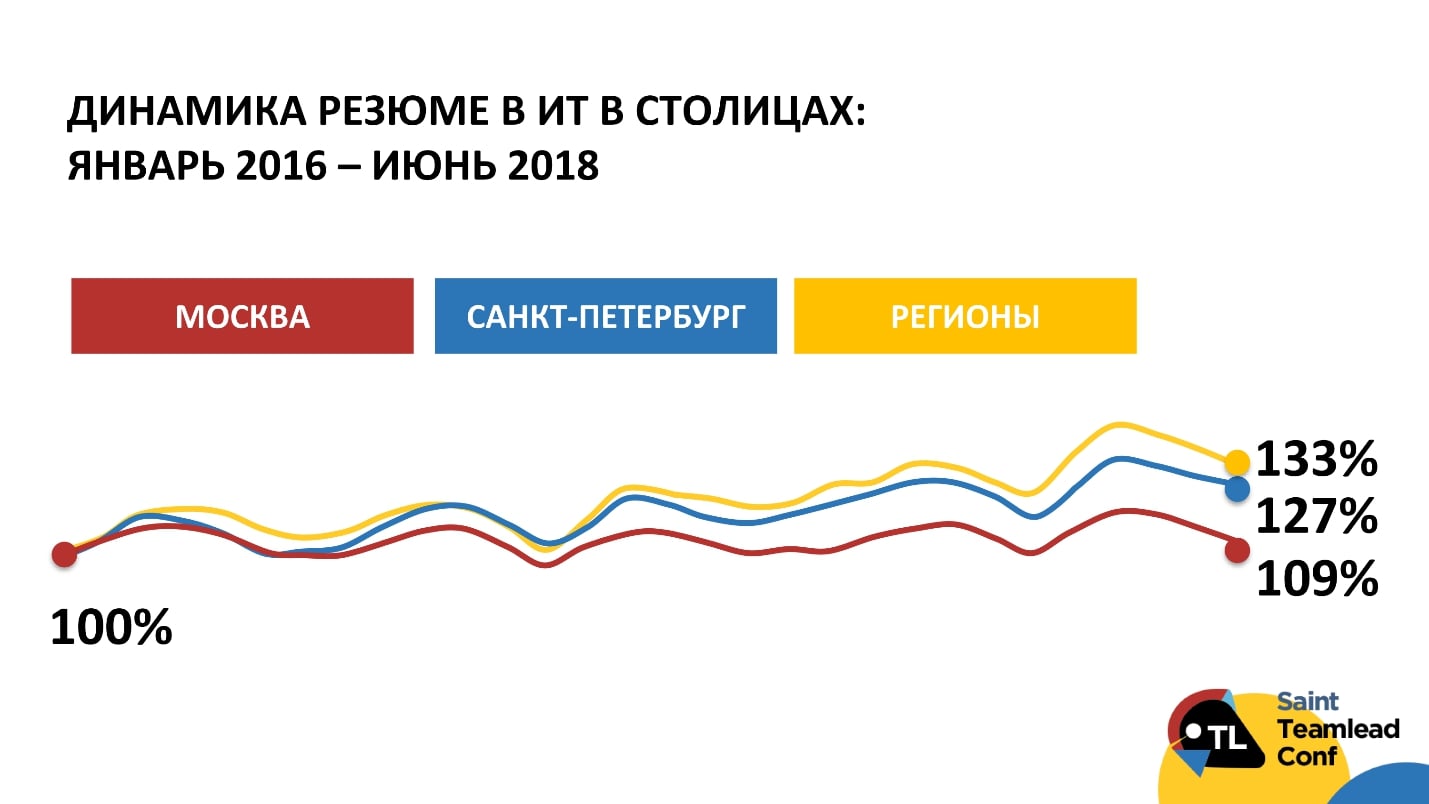
What about resume? The growth of their number is too disproportionate to the demand that developers now have. I would like to come to the customers and say that life will become easier, we will have more developers. But in these 30% lie the middle and the juna, and the preferences change from year to year. For example, now we are looking for a front-end developer who would work directly with React or Vue. Candidates choose companies just as well, they have a certain stack with which they want to interact. It turns out that from a huge tree of possibilities, only a small twig comes directly to us.
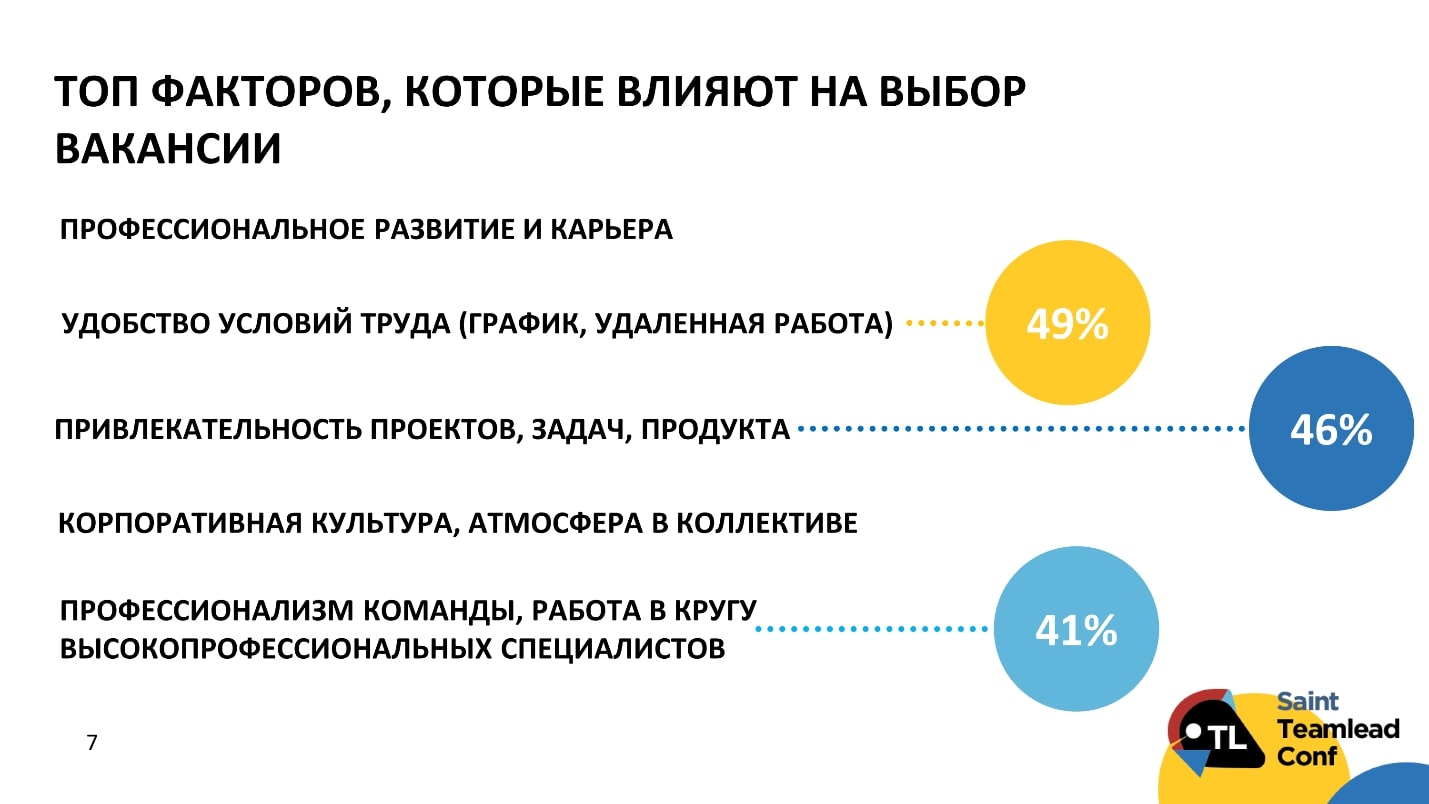
Why is the role of team leader crucial? Of course, salary and professional development is good, we will not get away from it, these are basic needs. But work is a human-person interaction., even if it is a remote command. A professional team works with strong people. Timlid is the face of the team itself , much depends on how he will conduct the interview. Whether he can tell about these factors or not determines a very large percentage of success.
Therefore, below we will go through each point of the interaction of the team leader with the candidate.
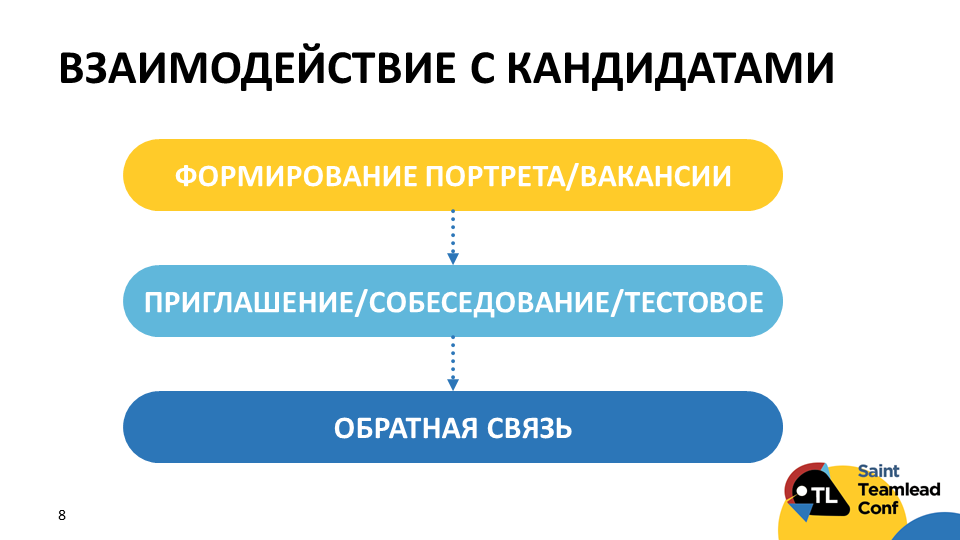
Portrait formation
This is where the role of team leader begins in the hiring process. I'll tell you how it happens with us.
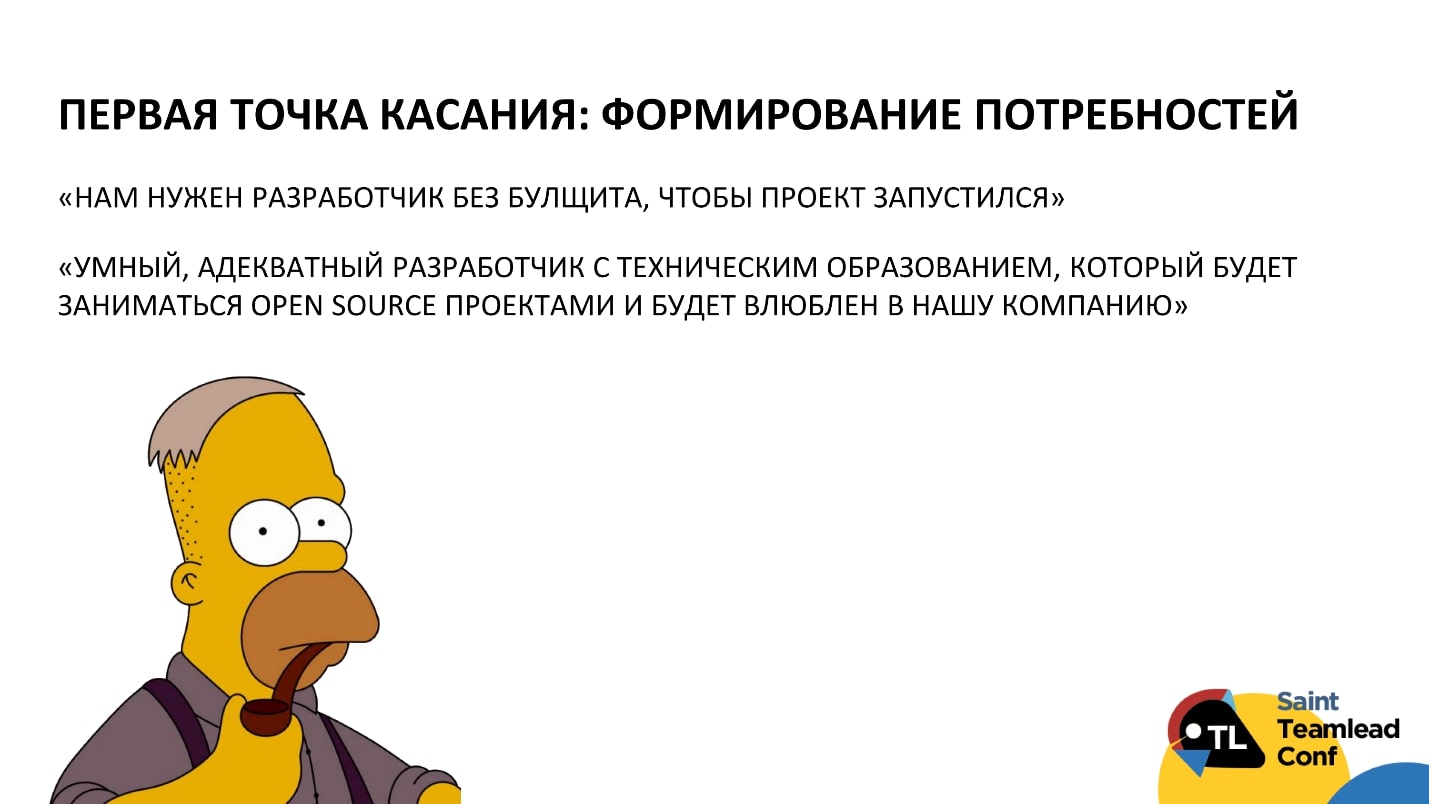
On the slide above, there are real quotes of the timblids who come to us. To the question “What tasks will he solve after all?”, We are often answered: “Well, code it!”
For example, we are looking for developers for a project to create maps for autonomous machines (working in the United States, salary in foreign currency, etc. ), but the founder does not want to tell who is in the team, how tasks will be distributed directly - as a result, the conversion drops. Everyone says, “Oh, Self-driving car! Very interesting! ”, But at the second stage (interviews) they refuse because they do not understand what they will do directly within the team.
My other favorite query is lead or CTO.
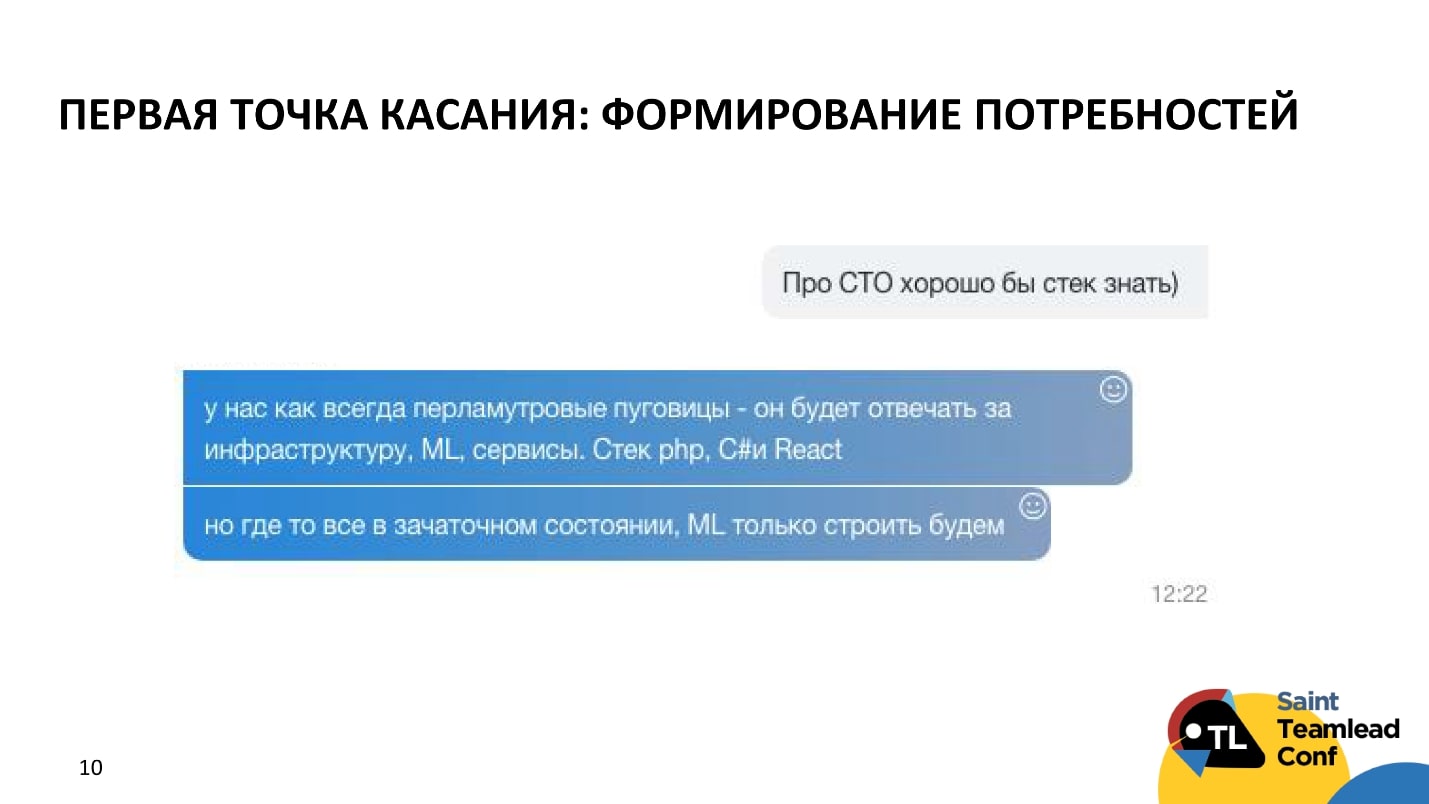
If I offer you such a request, will you respond to this vacancy, will you start a dialogue with the company? Most likely, the answer will be negative.
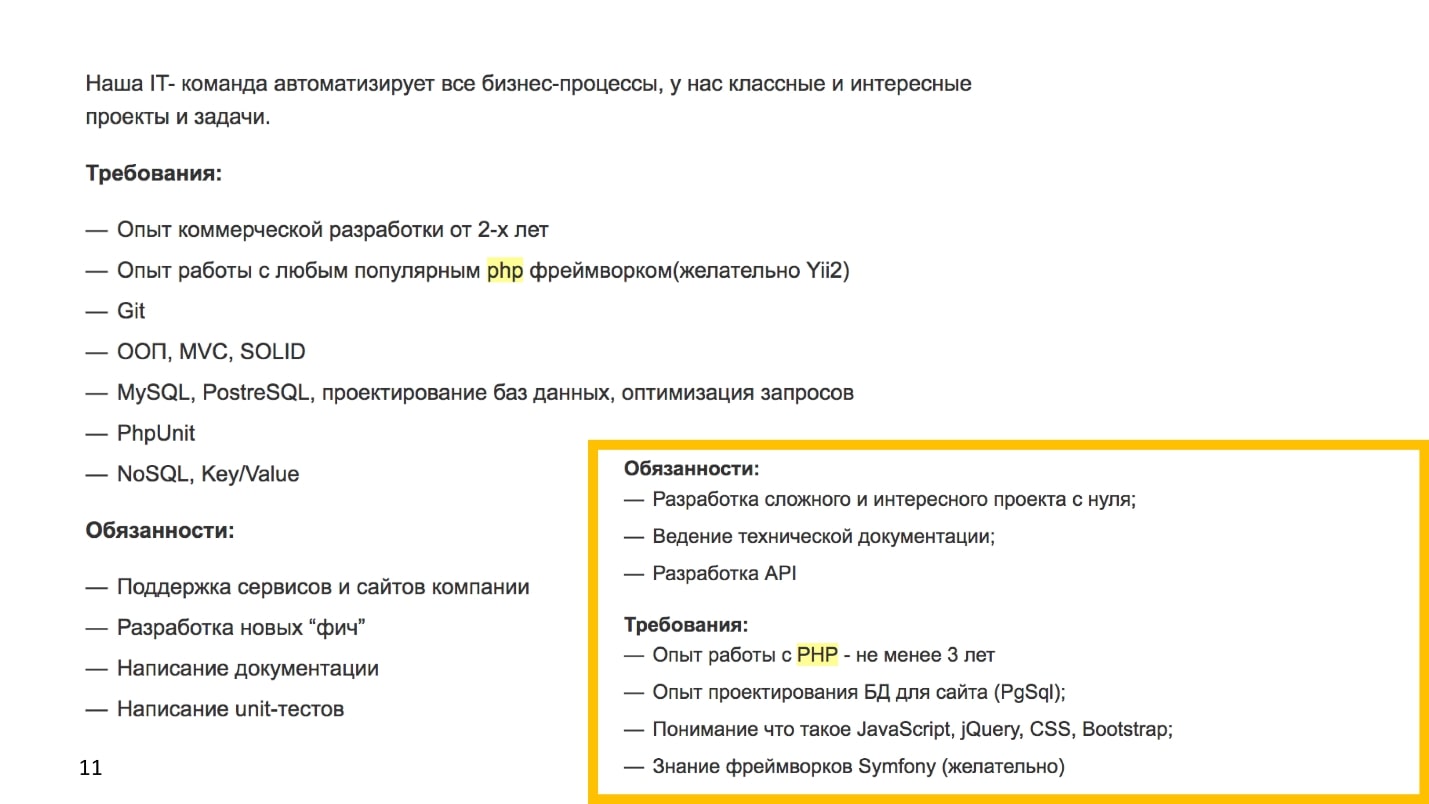
I see the same list, I don’t know the company, I don’t understand how I can choose where to go.
Often, a job description is built without a clear portrait - just a request for technicians with experience with a specific technology for 2-3 years. All the teams want such candidates - it doesn't matter if you are a large company or a small one, but all job descriptions are exactly the same .
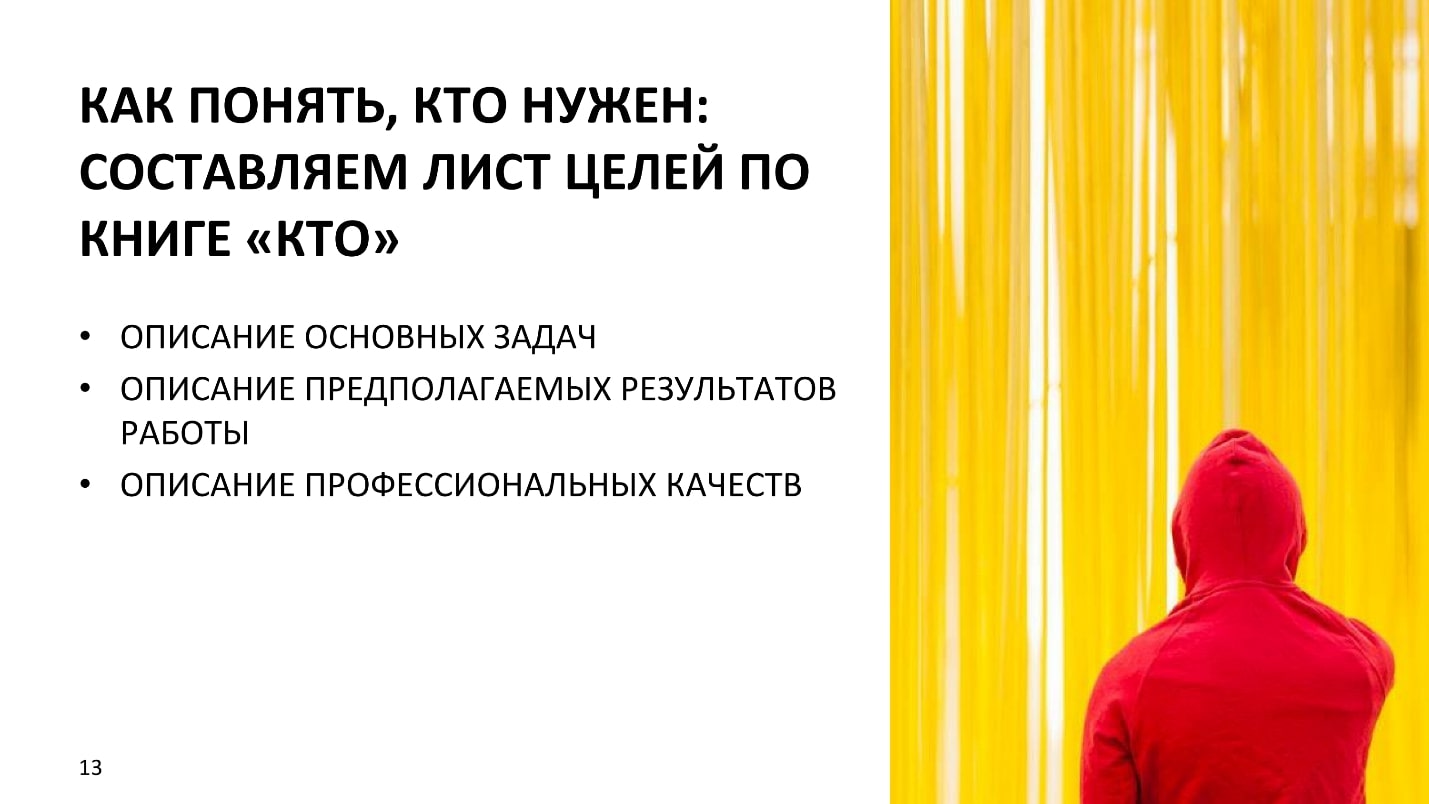
In my favorite book by Jeff Smart and Randy Street, “Who. Solve your problem number one ”describes the problem of voodoo-recruiting, when the interviewer during the interview relies only on intuition. To avoid speculation, the authors forbid to say that the candidate did not like it until you understand exactly why. The book has a very clear recommendation for the compilation of a description of the position: we form a demand for skills from tasks, from this we go to professional and personal qualities .
In addition, it is impossible to refuse a person during an interview, because he didn’t like the color of his jeans, or he was 5 minutes late, or something else. Everyone has personal problems. Even if a person uncertainly talks about his subject area and could not “sell” himself at the interview - this is not a problem. He is a developer, you do not hire salespeople.
We go from the contrary
If I do not know who I like, then I know exactly who I do not like. The path from the opposite can show itself well. When I first hired employees to join my team, I also went from the opposite. If you have to create a portrait (job) for the first time, remember that it must be personalized .
I'll tell you a case from our practice, which is very well remembered, because it was my first replacement in life. We formed a team from scratch, there was no legacy. Everything was great - there was a timlid, and he took the developer. At that time we worked in the same coworking, I came to work by 9-10 am, I saw that their team was already at work, but did not pay attention to what was really going on. Then it turned out that the new developer came to work as I had at 9-10, and the rest of the team came by 8 am and could not dock with the new one. They had a different outlook: they are the larks, who value their free time and the opportunity to leave at 16-17 hours, to devote time to family, sports, and self-development. And for a newcomer, working up to 20-21 was in the order of things. We changed the job description and specified we start work from 8 am, because we value the personal time of the staff. As a result, the number of responses greatly decreased, but candidates began to invite their lark friends - where else can you find work to free yourself at 16 o'clock?
I'll tell you another story about the same company. This company is engaged in the automation of advertising on the Internet, you already think: "How boring you will never tell your loved ones what you are doing."
Timlid came up with the following (they also value personal time): telling candidates that the company provides an opportunity to refuse manual labor and engage in more intellectual tasks to those people who are engaged in advertising on the Internet. And here they are no longer advertising, but a social service that allows other people to engage in more interesting work.
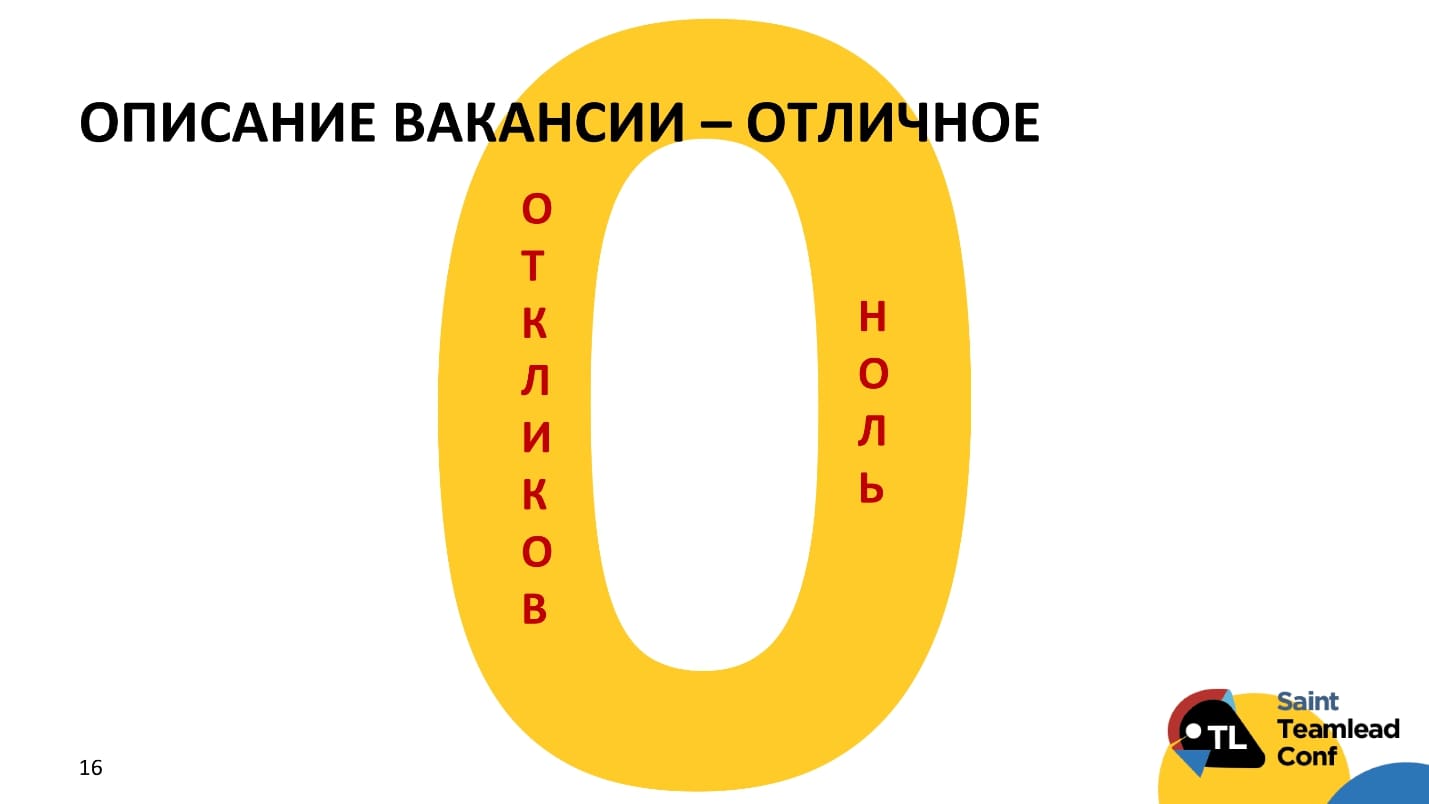
Job description can be very cool, you are cool about the product, but through what channels? If your main tool is only work sites, then there will be zero responses. Maybe there will be fifteen of them - including a resume and a secretary, a mechanic, and an accountant.
Job Placement
I will tell the story about one American project with which we work - this is a service for perfume delivery by subscription in the USA. The company is called Scentbird, almost nobody knew them before in the Russian market. They needed Java developers. We could write: “This is a perfume delivery project” and then the developer will say: “What ?! I will not go to work in the online store, and even perfume! "
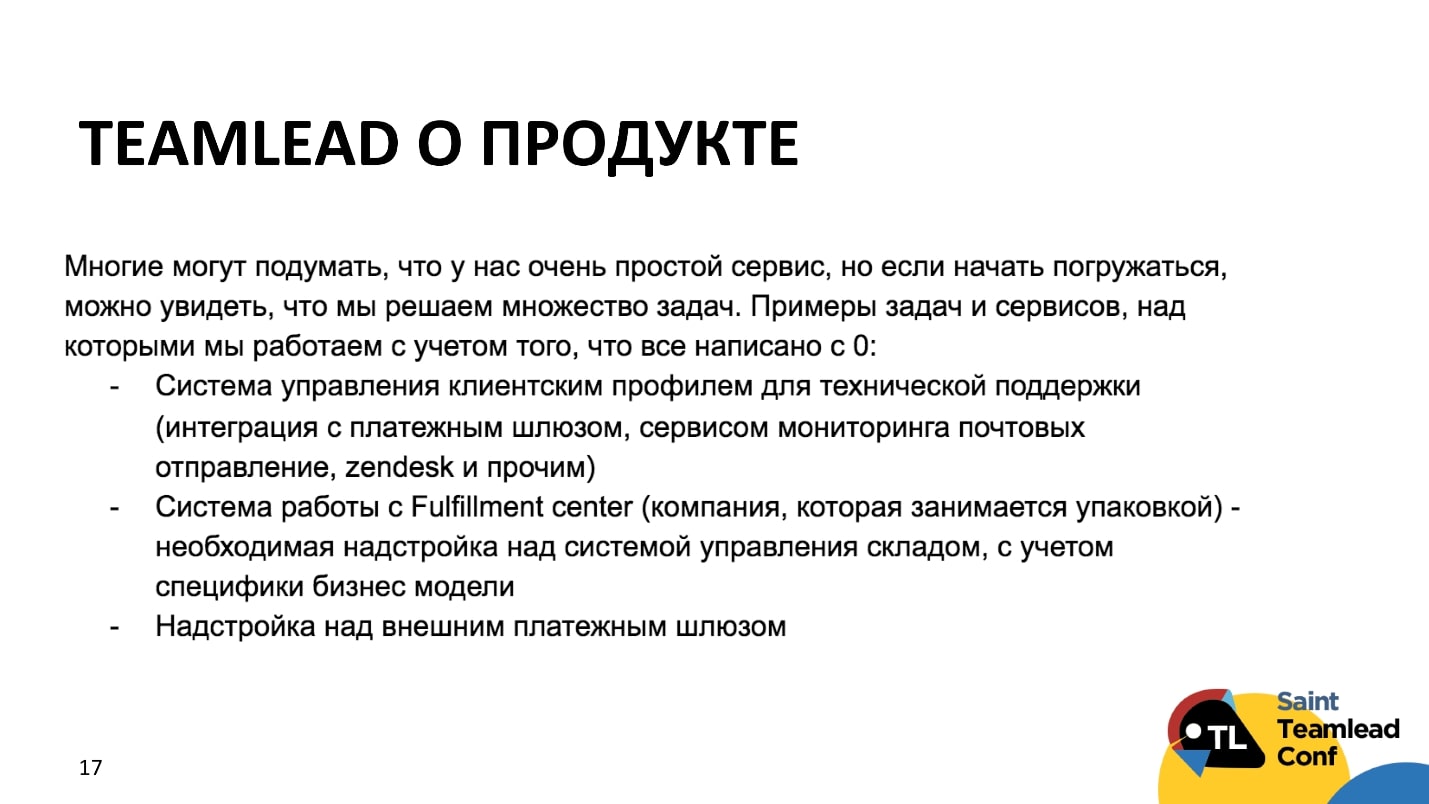
And here CTO does a very cool and simple thing. “Many may think that we have a simple service,” he begins his post in FB in the format of a google document, and distributes it through various chats. In chat rooms they do not really like vacancies that lead to work sites, but this super document immediately processes all objections. He also talks about the fact that the project has its own Fulfilment, complex user accounts, payment gateway. It seems to be just a project from the beauty sphere - but no!

This is a story about a team in which the phrase “I can talk about my team for a very long time” immediately forms a portrait of the future leader. He writes in the first person. An impersonal "cool team" or "cool team, they have ..." (third person) work worse. When you read that "... 27 people work with me", I want to say: "Let me be the 28th!"

In fact, google-doc is dynamic, there are regularly removed jobs that are closed, add new ones, and talk about how people are evaluated. For example, there is the position of a Senior Java-developer, and the author immediately writes who, in his understanding, is a Senior-developer, and who is not. It becomes immediately clear whether you want to go to this team or not.
We will come back to this job description several more times, because this is a very convertible case. 15 developers came directly and there are those who, after an unsuccessful interview, periodically ask if they can try again.
Resume evaluation
The next touch point is the evaluation of the resume.
Suppose we have found a way to attract cool developers who are not looking for work. If such a person writes you, then it is not necessary to ask for a resume, it is better to ask to send a profile to GitHub or something like that. It seems to me that approximately 40% of all vacancies we work with are hired by people without a resume.
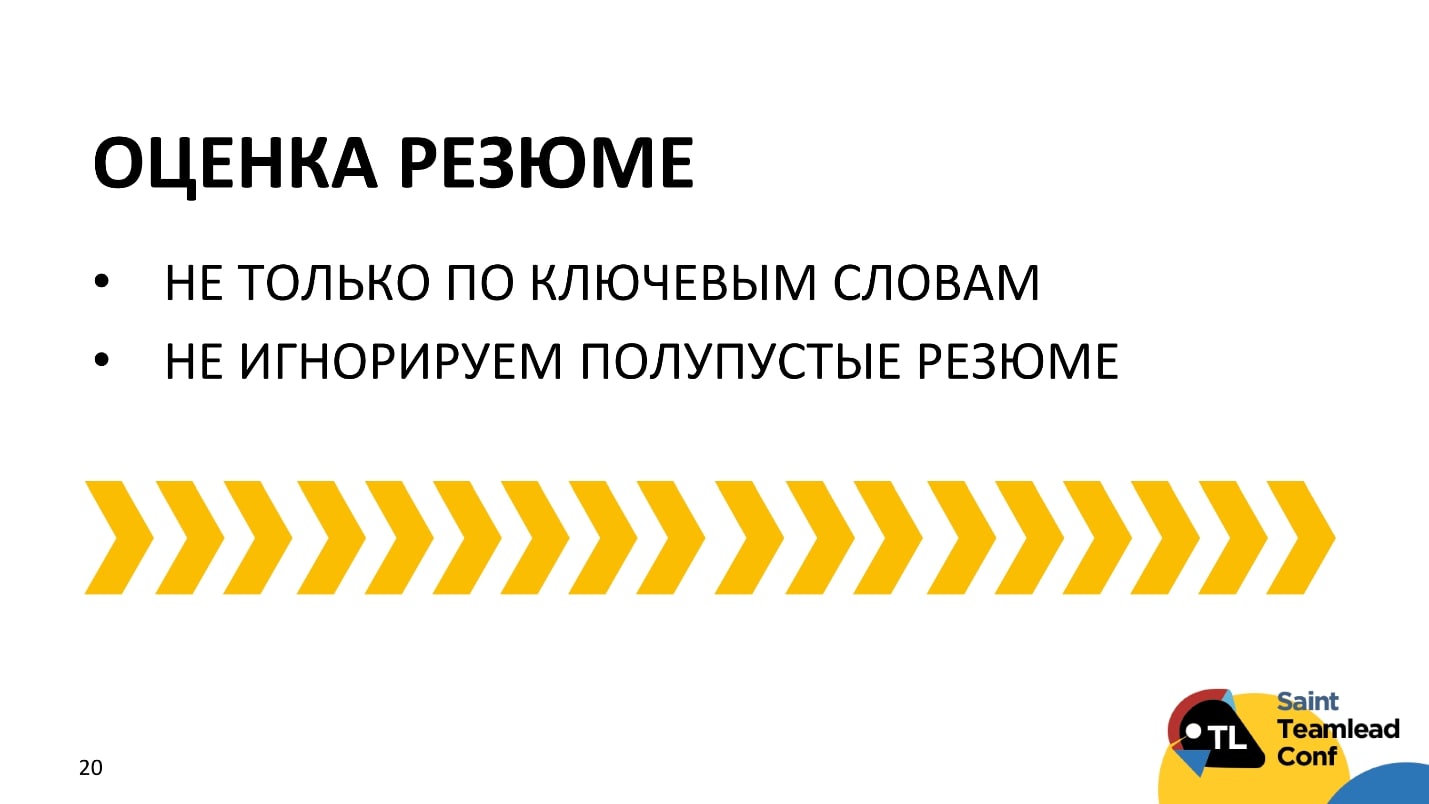
LinkedIn holds a conference every year about its service. Last year, they spent an hour talking about the fact that the most unfilled profiles on LinkedIn are the most accurate, because if a developer has a well-filled profile on LinkedIn, his email client will be full, which few people like.
Invitation to an interview
When HR writes a developer, 8 out of 10 say no. But we know how to work with it. I conducted an experiment and wrote on behalf of the Timblids with whom we work. Then already 5 people say no, and 5 agree. At the same time, the refused say: “Listen, cool story! Let's talk on Skype, maybe just for the future! ”
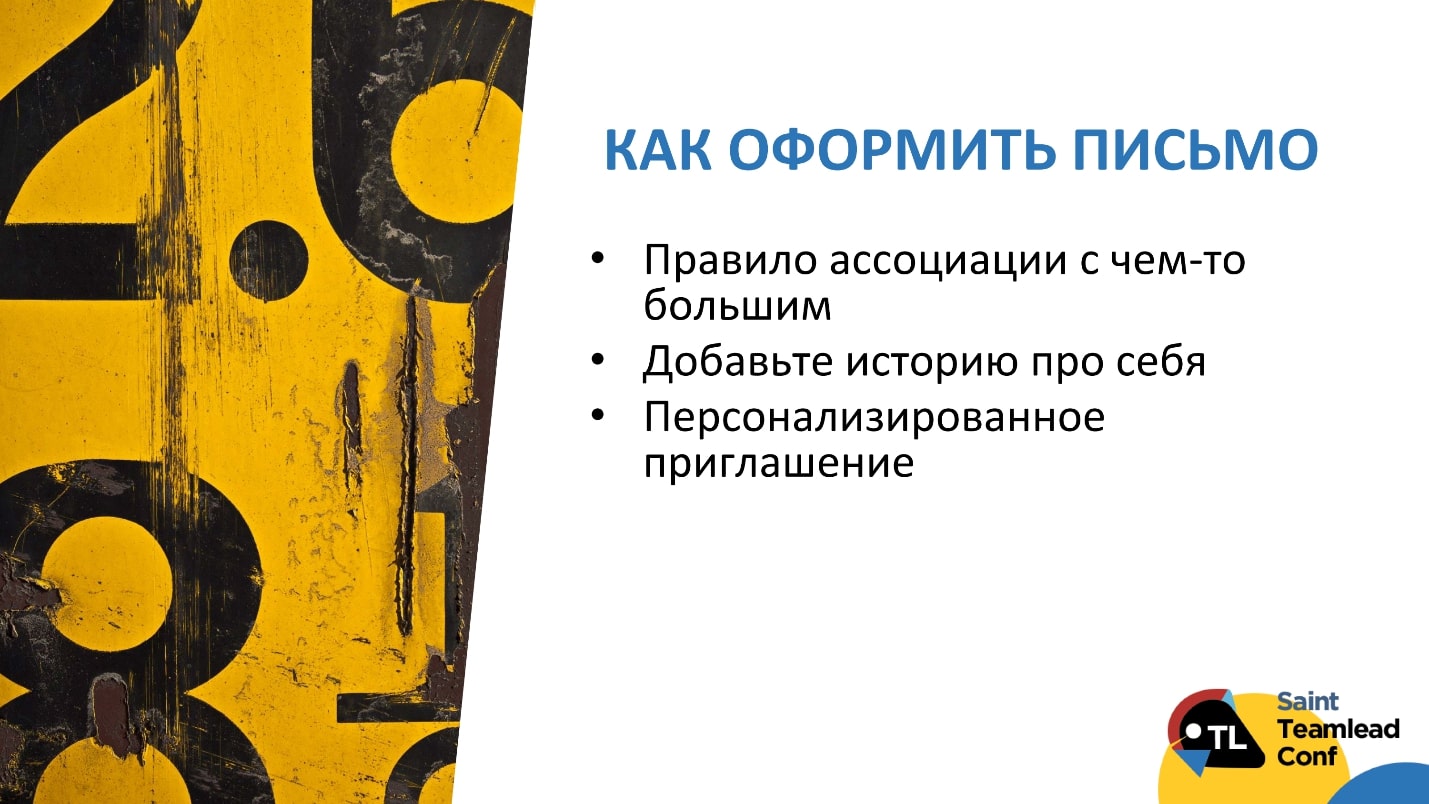
If you don’t have a very well-known company or, on the contrary, it has a very well-known name and reputation, it works very well when you give a link to educational materials on that technology in an invitation to an interview with which you work. You can, for example, write that you were at the TeamLead Conf conference: "Here is my presentation" or "I participated and I really liked this, come, we will discuss this with you."
So the candidate begins to associate not the Kitty company with the cat, but the company with the person who is engaged in professional development.
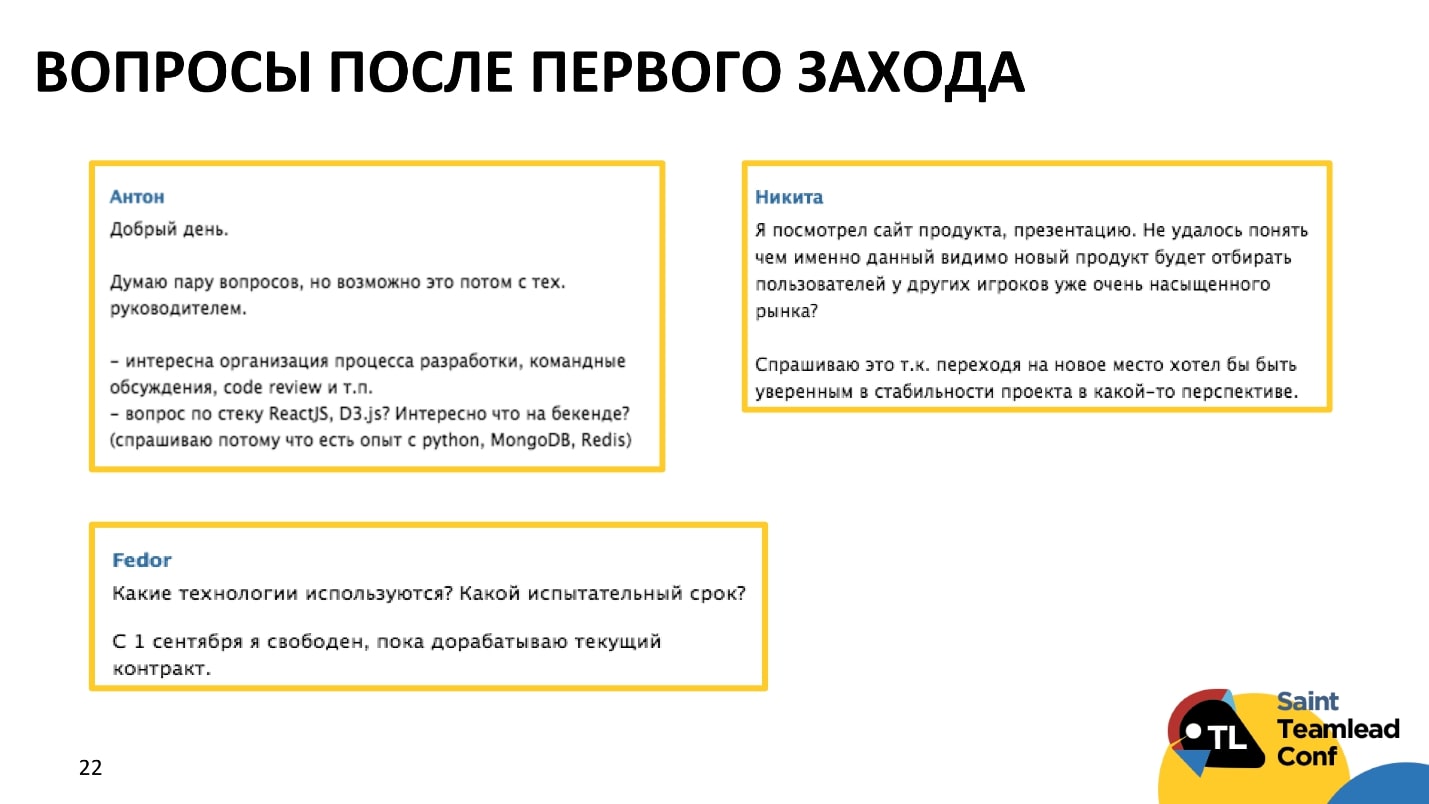
Above are some of the questions asked after the first letter - people lack information. As I said, according to statistics for 50% of applicants, a rather important parameter is the work schedule. There are also many questions about the internal structure of the development team. It is difficult to convince a person to join a team in which the processes have not yet been built. If they are not lined up, you can honestly say that they are not lined up.
Interview
As a rule, this stage consists of three stages:
The structure of the interview, plus or minus, is the same everywhere; each of the stages differs only in the depth of the questions you ask. You save your time.
There is a magical history with Skype . For example, there is an agreement that Skype interview should begin at 7 o'clock. After 10 minutes, the first side first writes us, then the second: “He doesn’t add me to Skype, I don’t understand where this person is.” For me there is no answer to the question why this is happening. I know that HR sometimes makes Skype talk for three, otherwise everyone is waiting for someone to add when.
Also, you need to remember that since there is no opportunity to broadcast personal charisma in a Skype conversation, the story about the company and about yourself takes a little more time. If in a personal interview, 10-15 minutes is enough, then on Skype it is rather 15-20, because the interviewee does not see you and it is more difficult to gain his confidence.
In my experience with Skype, there was another difficulty when the team led the interview in 5-10 minutes. We’re the candidate's hunt, and after 5 minutes the timlid hangs up and says that he’s not suitable. You shouldn't do that, even if from the first meeting it seems to you that the candidate will definitely fit, because it spoils the reputation and the company's HR brand.
Interview structure
For those who are just starting to conduct interviews on their own, it is often difficult to keep in your head the entire list of questions that need to be asked. There is such a technique, which is called "Funnel": we begin to dig one case and gradually find out who the person was in the team, all the reasons why it happened, that he left, and so on. Sophisticated telephone interviews save your personal time.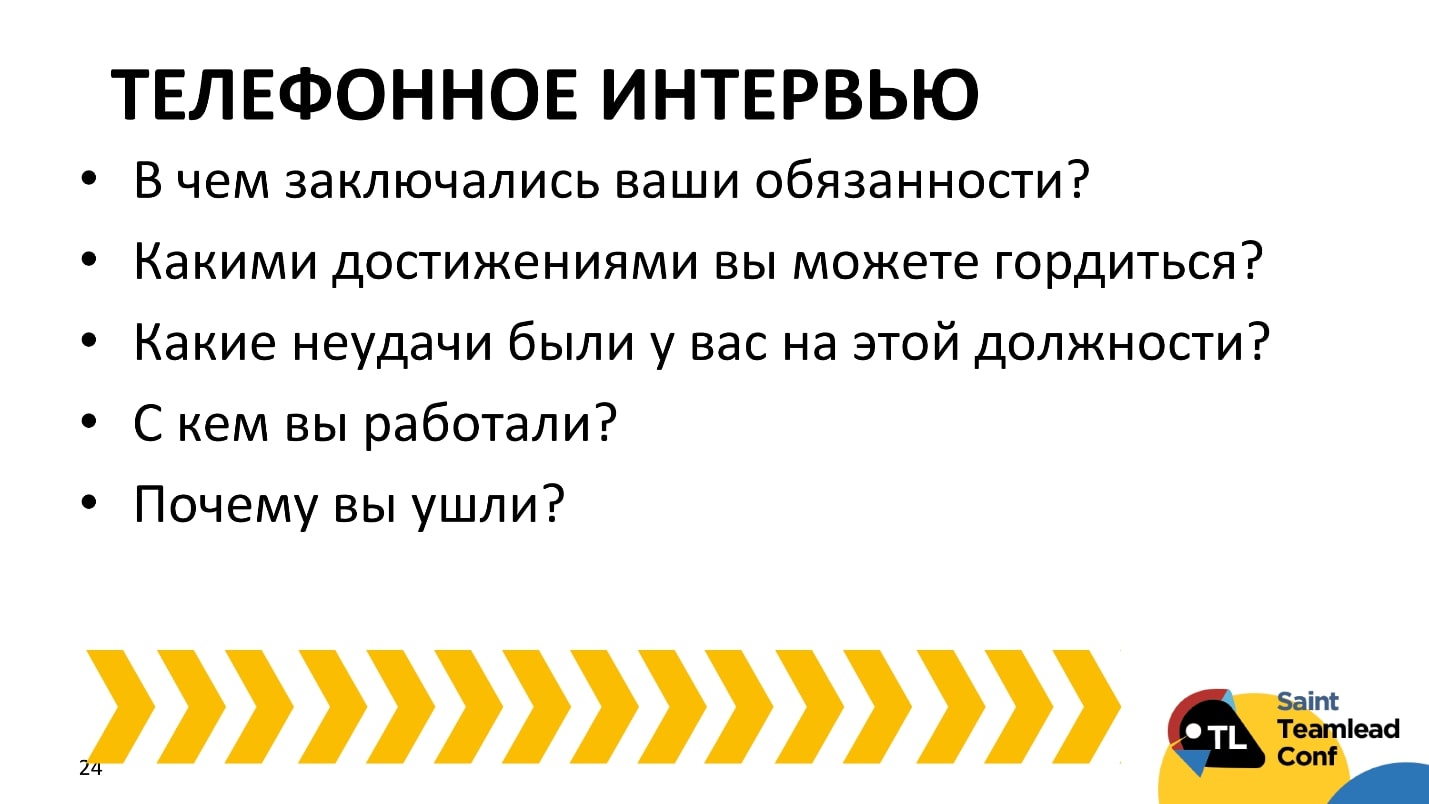
Interview
The next point of contact between the team leader and the candidate is a personal meeting . The question here is whether the candidate will work for you or not. The quality of the prepared technical interviews and case studies can greatly influence his decision. In the book “Who” it is recommended to transfer the records to each other, so as not to ask the person 10 times why he came to the interview or why he left the previous place of work, this quickly begins to annoy.
For projects in which they conduct 5-7 interviews for one candidate, we have a very bad conversion. A large HR brand can afford to choose carefully and stretch the hiring process, but it is very painful for small teams .
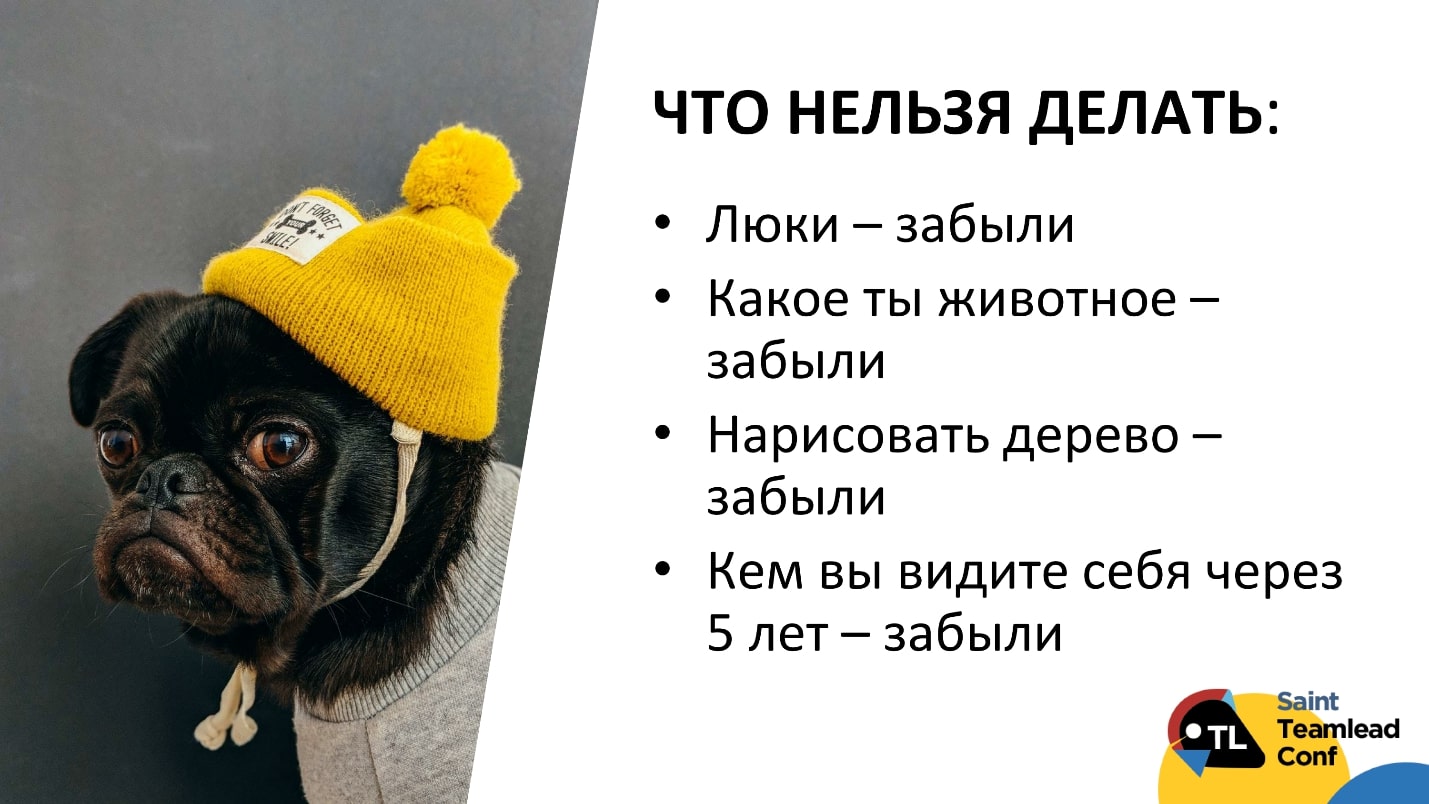
I would like to have the opportunity not to talk about it, but above my top questions, on which the candidate also decides whether he will work with you or not. With the question “What kind of animal are you?” This year I came across for the first time in my life. We no longer work with this company, and I just don’t know what at this moment you can appreciate, why ask it.
It’s good if I say what will happen to me in six months, but maybe I can’t foresee this either.
Another very cozy topic is the story about the company . It can be put at the beginning of the interview or at the end. It seems to me that it is good to put both there and there, but if a person has already come to your meeting or agreed to a Skype interview, then he most likely already knows something about the company. This is an ideal, otherwise he does not value his time.
When our company decides whether we will work with the team, I ask the immediate customer: “Why did you come to this company? What is your story? How did you choose? Why this offer? What difficulties, why did you doubt? ”And so on. When a person comes to you for an interview, you can also share your story of joining the company.
When we write that there is such a technical manager in the team, this does not always have additional value. Not every team leader is a media personality with a lot of performances. When I write that "This is Andrei, he has such a story, he came to this company and wants to solve a global social problem," it is more difficult for me, because I am not in the place of Andrei Timid. You can write on your own that "I came to the company to ...", etc.
For example, we came to a meeting at a large manufacturing company, and the first team member said: “I came, and here is a mess, I want to fully automate the procurement process. We have rather complex customers, because they have not come across IT in any way and do not know how to set tasks for us. But I like hardcore, and I want the same crazy rock-n-roller players in my team. ” Very clear and understandable.
If you know about some nuances of the reception area (this may scare away), then it is better to say about them immediately. For example, we started working in the incubator of the Higher School of Economics, we had two trees growing out of the building (I am not joking), and it looked extremely unattractive. When we invited candidates, we said: “We have a tree above the porch, go through, do not be alarmed, everything is fine inside!” This is important.

Above a good feedback after the interview. The person does not write about the cool office or super-good hygienic conditions. He says that he liked the interested, adequate, cool lead, which will work well.
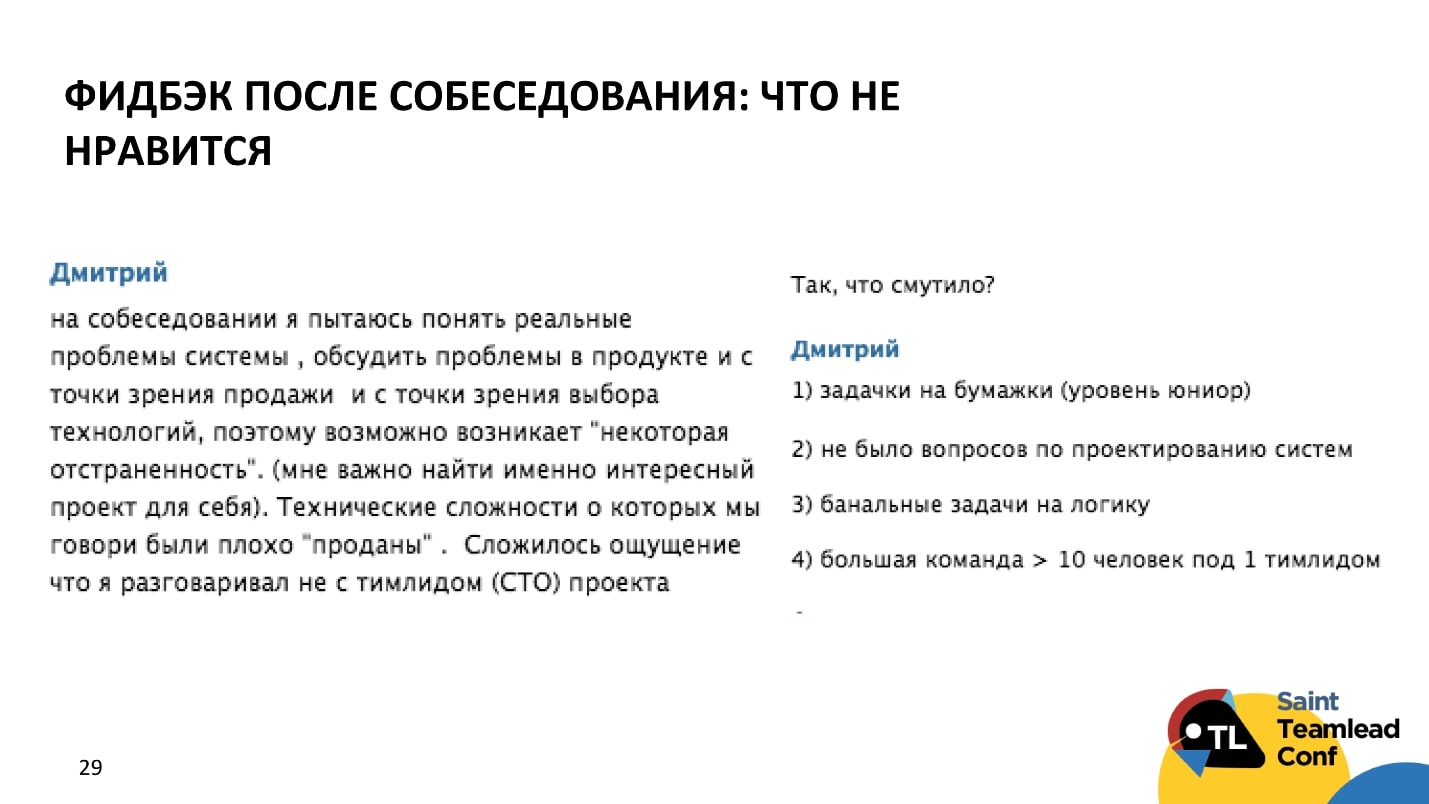
And this is a bad feedback. The candidate had the impression that he was not talking to the project lead team (CTO). This is partly due to the fact that all of us in childhood were told that bragging is bad. But when you hire, you need to deal with it, you need to adopt the thinking of the founders of successful projects, learn how to charge people with your ideas - and they read it.
If you do not have the feeling that you are a strong leader, you may encounter these problems. But for sure there is a solution: tell the candidate why you are here, why you are solving exactly this problem, why you work for this company. If you tell me how you chose the work yourself - the person will see that you are not fake. He will understand that, perhaps, he himself is the same and wants to do the same way.
Problems on a piece of paper

99% of our applicants say they do not want to do tasks on paper. Perhaps they will agree if you have a queue of candidates, but I do not guarantee a good result.
I asked people what they liked about the interviews, below are a few examples.
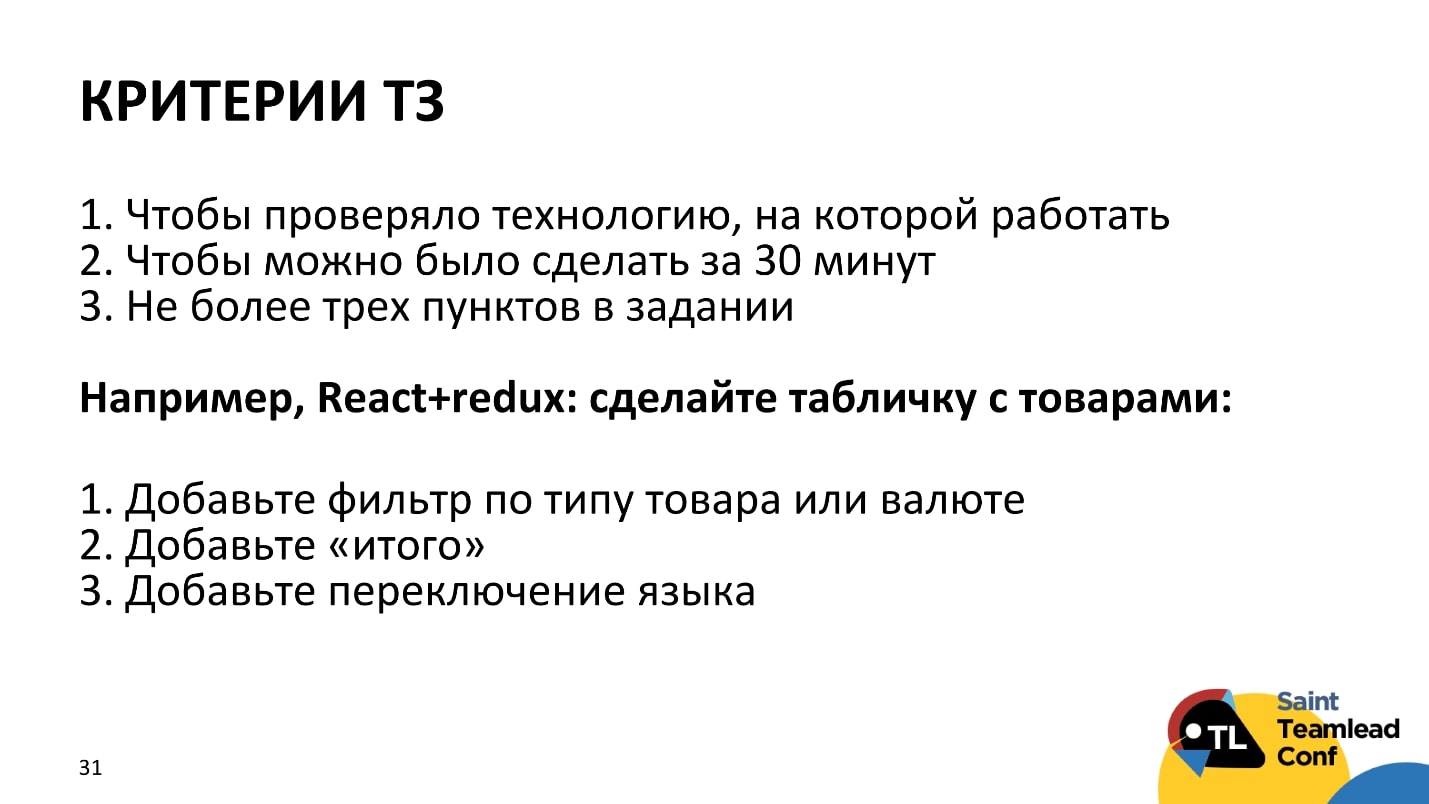
Everyone is delighted when they understand the problems the company faces in their daily work, for example: “Last week we had such a problem. How would you solve it? We solved it this way. ”
People like the fact that they are given technical tasks - this is the most interesting of all. But be sure to immediately warn the applicant about how long the interview will last. Perhaps misunderstanding and resentment when the interview lasts more than an hour, especially if we ask a person to come before (the most acute story) or after work. I'm begging youto be flexible regarding the appointment time of the interview , because cool people usually work and it’s rather hard for them to take time off from the current workplace, especially since they are usually loyal and responsible.
Test items
“I received the last letter, thank you, I will” - and that’s it! Man sucked black hole, we do not know where to look for him. He does not answer us or Timlid.
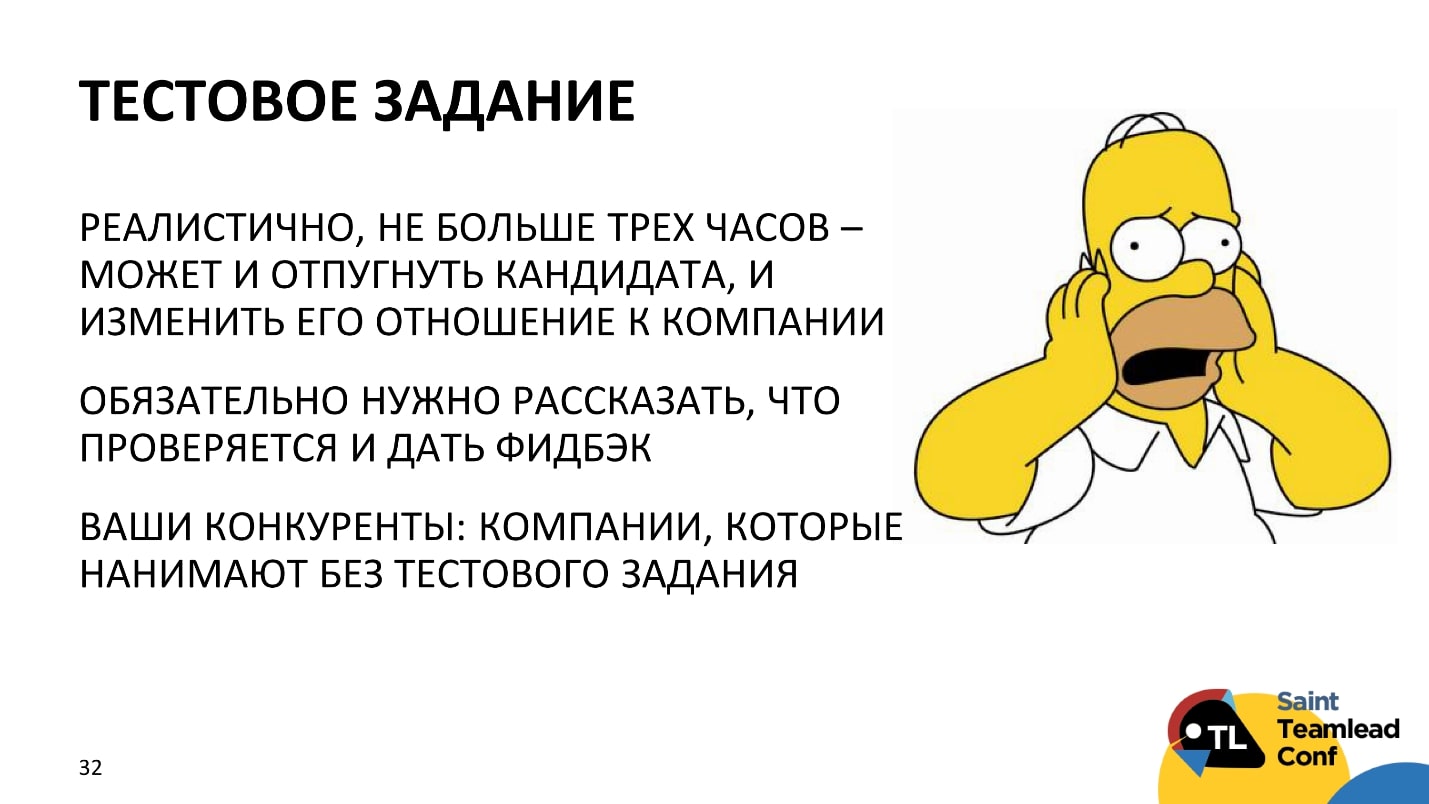
You also need to understand that the market is very competitive. There are companies that conduct all the test tasks at the meeting, and at home there will be more distractions.
Even with this, you can also live, if an extremely important parameter for you is to give a good feedback after the test task. Below is one of the feedbacks.
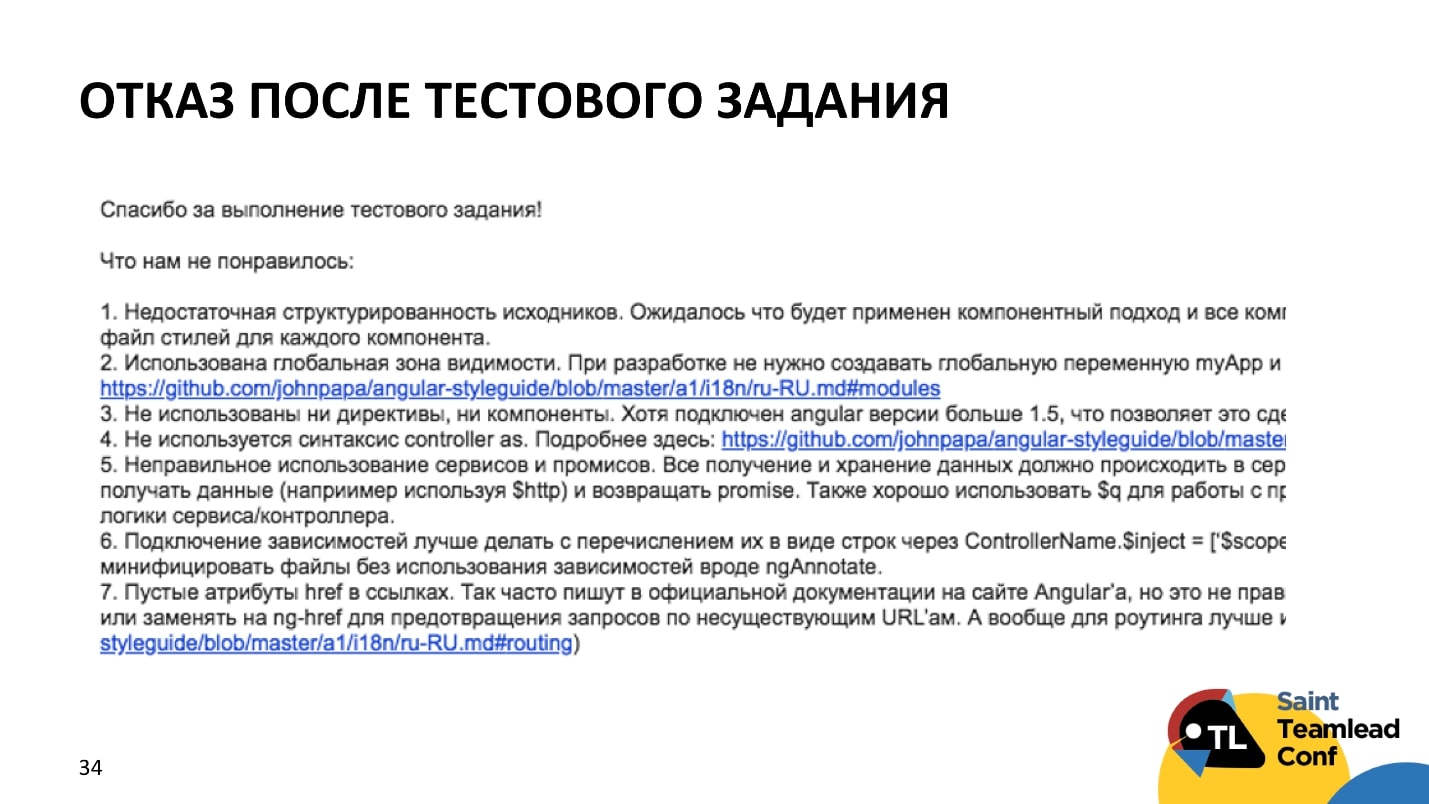
Its essence is that here, at least 7 points, and not just a refusal. Laconic waiver is also offended, as the complete lack of feedback. The candidate solved the problem - he wants to get feedback and, ideally, find out what he coped with and what he did not.
Renouncement
Back to the pain during the interview. Everyone had such cases - it takes 10 minutes, and in my head sounds: “Failure! Why am I here? I want to leave as soon as possible! No, it is impossible, HR will come and say that everything is bad, I ruined the HR brand. ” You can work with this too: turn on the rule of six handshakes and say: “Listen, you did not cope with this technical task and this one. We can't hire you, but recommend me your friends. Maybe some of them will suit us. ”
According to feedback on the slide above, the developer recommended his two friends. He himself did not go to work, but he liked it so much how the interview went, including refusal after the interview, that he recommended us to his acquaintances. Without even telling the team leader, he sent out test tasks for them: two did, and one went to work.
Labor Law Failure
This is a very delicate question, and it arises more often when the applicant did not immediately like it and he wants to refuse by personal qualities. Now every year this line is becoming more subtle due to legislation. We can refuse only by professional skills, and this must be remembered. Today, developers know their rights, especially if it is the one who is hard to find work.
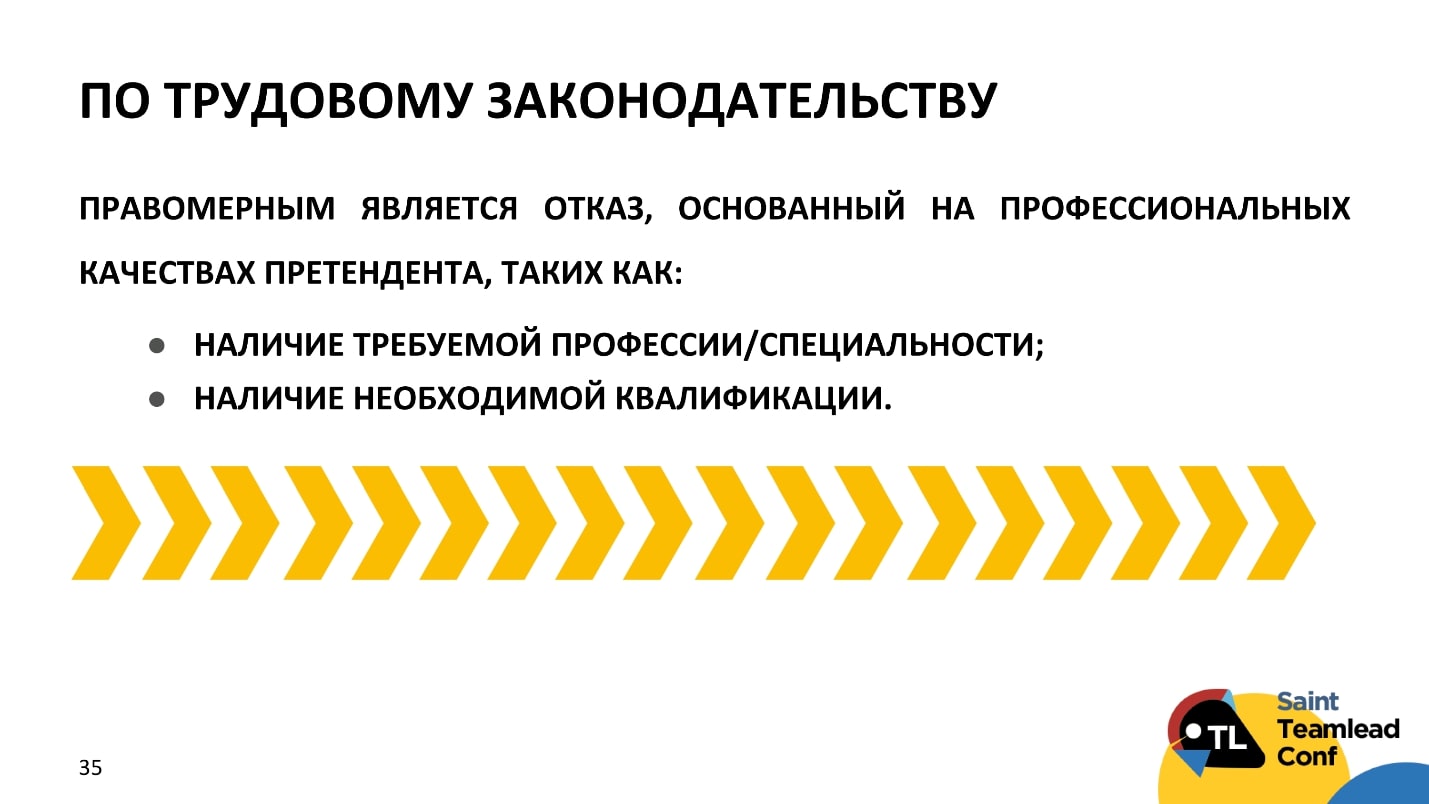
One person told us: “I’ll collect refusals for personal qualities and go to the labor inspectorate — I’m making money this way!” These are scary people, so we do good technical interviews and refuse professional skills, especially since it can give us new applicants .
Under labor law for unreasonable refusal:
The penalty seems to be not very scary, but the second point is much more difficult - the labor inspection can force you to hire this person. I hope that this will never happen to you, but there are no precedents for technical specialties.
After the interview, but even before the job-offer, even if you understand that this is not the most relevant person for you, it is important for him to write (you also have his contacts, you invited him): “Thank you for the meeting, it was very interesting, we will continue the dialogue. It works very well. So you increase the points of contact.
Job offer
3-5 years ago the job-offer looked like this: letterhead, company name, text: “Come, Peter, we are glad to see you. Such-and-such salary ”and signature of the general director.
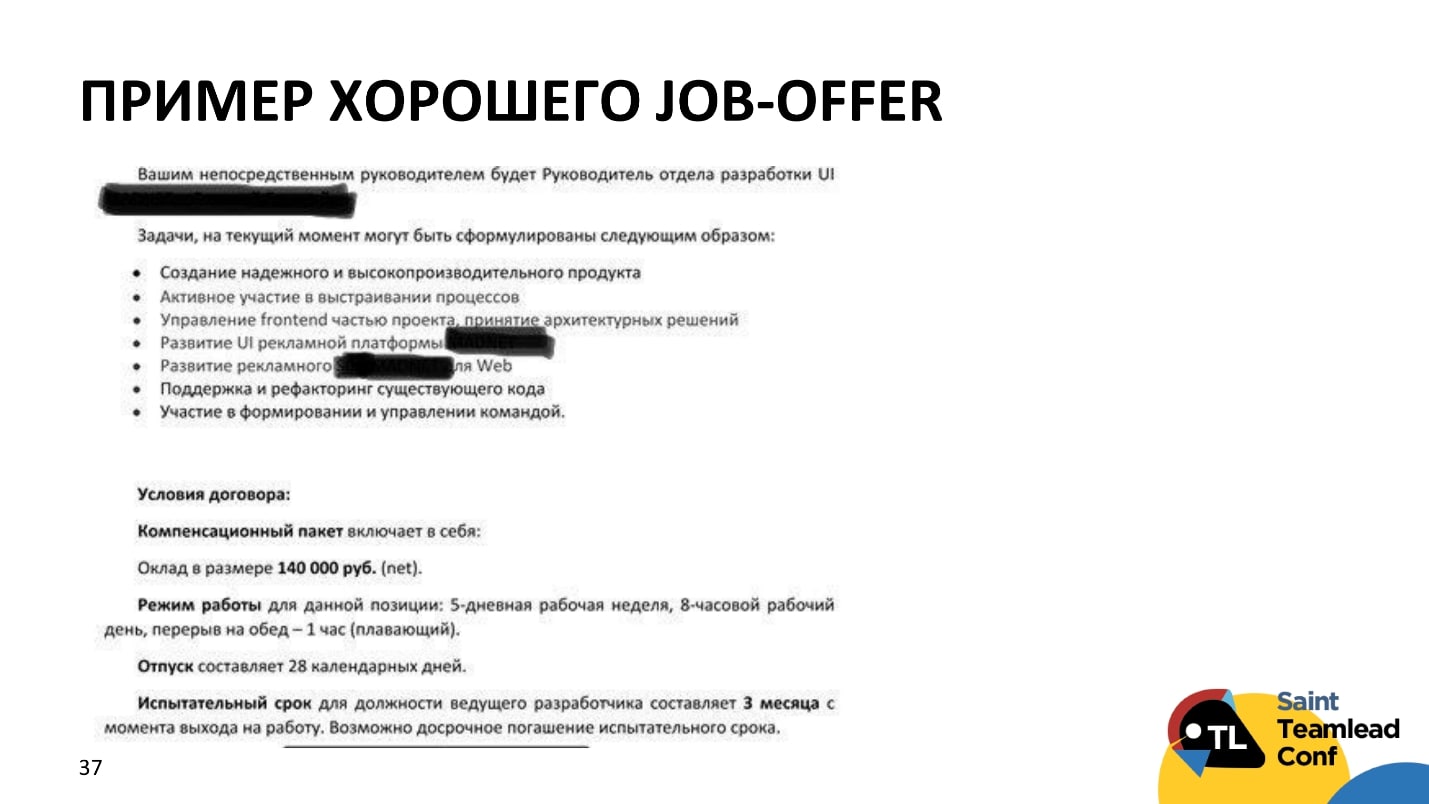
Now in the job-offer, everyone wants to see the tasks you will be facing, the criteria for completing the probation period , the contacts of the lead, with whom you will work and who can ask questions about the job-offer.
If, on the job-offer, you were told that you need to think about 2-3 days, then this is a very good sign. In 99% of cases the candidate will accept the offer. If the answer (often in the real world is the case): “I need 1.5-2 weeks”, then it immediately seems that there are still competing job offers. But you again have a personal contact and you can ask in a personal: “Listen, you probably have something else else - how do you choose a company?”
Candidate refuses from job-offer
For example, a week and a half passes, a person refuses, but we are not sad! It really works when the lead squeezes the candidate himself. “Boost” - sounds strange, but it really is.
In the book “Who” they recommend taking notes in the interview process, including recording the reason for leaving, with which the person wants to work further - the entire set of arguments. All counter-offers from within the company are so easily processed. The person is being held by the current employer, and you remind him that he does not like his manager. The story that they don’t leave the company, they leave the leader really happens, and quite often.
If you have worked all the arguments, after the new 1.5-2 weeks, the result can be positive in your direction, even if the proposed salary is lower than the offer that he wants to accept. Salary is an important parameter, but in my entire history only ten people can remember who really sold their souls, doing projects that they did not like.
A bad result is a person who refuses your offer. But we already know that from each cool interview and from each missed offer you can convert 2-3 contacts - both contacts of recommenders and those who may be suitable for a vacancy.
You already have a contact person who knows that you are cool. Even if he refused a job-offer at a meeting, you can write to him in a week and a half: “It’s a pity that you refused. I can not find a person in the team. Please recommend someone or give me references to people. ” So, too, 2-3 people can come and agree to work with you.
What needs to be done right now?
Right now you need to understand whether you are shooting at sparrows, whether your message is correct, and whether you really will attract those candidates with whom you want to work. Throw a vacancy with a critical eye and consider whether you want to respond to it . If not, rewrite it from yourself.
Of course, we live in a world where there is not enough time for anything, especially the Timlid. But you need to spend 6-8 hours of work to open a vacancy.: formation of needs, preparation of descriptions, list of questions, test tasks for interviews and all cases. Plus, there is also a list of methodological materials that can be given either at the meeting immediately, or sent after the test task or after refusal: “Here is the report, look! Here is a cool book, you should read it so that you can work with us further! ”
After that, you do not have to spend much time on feedback for each candidate. You can send one of the prepared templates based on the fact that it is more suitable for a specific person.
After the conference, Catherine gathered the most frequent questions and posted answers to facebook , all of a sudden, they would help solve someone's pain:
For hiring is almost fatal if the timlid withdraws from the process. Your personal history can sell a job as easily to a candidate as no HR brand can. Under the conditions of shortage of personnel, the role of the team leader in recruiting is one of the leading ones.

The report of Katerina Gavrilova on Saint TeamLead Conf gives quite specific, not too time-consuming recommendations for managers who want to hire their people into their team and not spend half a year searching.
About the speaker: Katerina Gavrilova ( katerinadhr ) has been in recruitment for many years, since 2011 she has been the founder and head of the recruitment agency DigitalHR, which deals exclusively with the search for Digital and IT specialists.
Mostly we work with small teams, in which most often there is no HR of their own. This experience shows that a team leader plays a key role in hiring new employees, and a lot depends on how the interview goes, how he invites a person. This will be the focus of today's story, and not on interaction with HR or external recruiters.

Most of all I support small teams that are really hard to find someone. I will not talk about companies that receive 100 vacancy responses and can carry out all the most difficult stages of hiring, for example, as Facebook or Google does. This is all cool, but very far from the real world.
The hiring process usually begins with the fact that the timlid thinks that now he will make a cool job description, post it, get a lot of feedback and choose.

We think that we will close the vacancy in 2 weeks, or at least in a month. But in fact, either we do not receive any feedback at all, or from very compromise candidates. Probably every third team leader with whom we work says: “In general, everything is fine, but I don’t want to hire him, because the cost of a mistake is extremely high.” Plus rejection of offers. There are objective reasons for this.

One of them - 120% growth of vacancies in IT. If earlier there was a boom of startups, for example, in e-commerce 10 candidates responded to a vacancy, now there are no more than 3-4 responses. This 120% growth is provided not only by large IT-companies that want to scale, but also by the production, which now hires IT-specialists. There are companies that are thinking about automating business processes. Yes, a simple cafe might think that if you do not like the CRM system, let's make our own and give a salary 2 times more. With this we live.

What about resume? The growth of their number is too disproportionate to the demand that developers now have. I would like to come to the customers and say that life will become easier, we will have more developers. But in these 30% lie the middle and the juna, and the preferences change from year to year. For example, now we are looking for a front-end developer who would work directly with React or Vue. Candidates choose companies just as well, they have a certain stack with which they want to interact. It turns out that from a huge tree of possibilities, only a small twig comes directly to us.

Why is the role of team leader crucial? Of course, salary and professional development is good, we will not get away from it, these are basic needs. But work is a human-person interaction., even if it is a remote command. A professional team works with strong people. Timlid is the face of the team itself , much depends on how he will conduct the interview. Whether he can tell about these factors or not determines a very large percentage of success.
Therefore, below we will go through each point of the interaction of the team leader with the candidate.

Portrait formation
This is where the role of team leader begins in the hiring process. I'll tell you how it happens with us.

On the slide above, there are real quotes of the timblids who come to us. To the question “What tasks will he solve after all?”, We are often answered: “Well, code it!”
For example, we are looking for developers for a project to create maps for autonomous machines (working in the United States, salary in foreign currency, etc. ), but the founder does not want to tell who is in the team, how tasks will be distributed directly - as a result, the conversion drops. Everyone says, “Oh, Self-driving car! Very interesting! ”, But at the second stage (interviews) they refuse because they do not understand what they will do directly within the team.
My other favorite query is lead or CTO.

If I offer you such a request, will you respond to this vacancy, will you start a dialogue with the company? Most likely, the answer will be negative.
If you go to the site with jobs or google "PHP-developer" or "Python-developer", it will open exactly the same job description.

I see the same list, I don’t know the company, I don’t understand how I can choose where to go.
Often, a job description is built without a clear portrait - just a request for technicians with experience with a specific technology for 2-3 years. All the teams want such candidates - it doesn't matter if you are a large company or a small one, but all job descriptions are exactly the same .

How to understand who is needed?
In my favorite book by Jeff Smart and Randy Street, “Who. Solve your problem number one ”describes the problem of voodoo-recruiting, when the interviewer during the interview relies only on intuition. To avoid speculation, the authors forbid to say that the candidate did not like it until you understand exactly why. The book has a very clear recommendation for the compilation of a description of the position: we form a demand for skills from tasks, from this we go to professional and personal qualities .
In addition, it is impossible to refuse a person during an interview, because he didn’t like the color of his jeans, or he was 5 minutes late, or something else. Everyone has personal problems. Even if a person uncertainly talks about his subject area and could not “sell” himself at the interview - this is not a problem. He is a developer, you do not hire salespeople.
We go from the contrary
If I do not know who I like, then I know exactly who I do not like. The path from the opposite can show itself well. When I first hired employees to join my team, I also went from the opposite. If you have to create a portrait (job) for the first time, remember that it must be personalized .
I'll tell you a case from our practice, which is very well remembered, because it was my first replacement in life. We formed a team from scratch, there was no legacy. Everything was great - there was a timlid, and he took the developer. At that time we worked in the same coworking, I came to work by 9-10 am, I saw that their team was already at work, but did not pay attention to what was really going on. Then it turned out that the new developer came to work as I had at 9-10, and the rest of the team came by 8 am and could not dock with the new one. They had a different outlook: they are the larks, who value their free time and the opportunity to leave at 16-17 hours, to devote time to family, sports, and self-development. And for a newcomer, working up to 20-21 was in the order of things. We changed the job description and specified we start work from 8 am, because we value the personal time of the staff. As a result, the number of responses greatly decreased, but candidates began to invite their lark friends - where else can you find work to free yourself at 16 o'clock?
I'll tell you another story about the same company. This company is engaged in the automation of advertising on the Internet, you already think: "How boring you will never tell your loved ones what you are doing."
Timlid came up with the following (they also value personal time): telling candidates that the company provides an opportunity to refuse manual labor and engage in more intellectual tasks to those people who are engaged in advertising on the Internet. And here they are no longer advertising, but a social service that allows other people to engage in more interesting work.

Job description can be very cool, you are cool about the product, but through what channels? If your main tool is only work sites, then there will be zero responses. Maybe there will be fifteen of them - including a resume and a secretary, a mechanic, and an accountant.
Job Placement
I will tell the story about one American project with which we work - this is a service for perfume delivery by subscription in the USA. The company is called Scentbird, almost nobody knew them before in the Russian market. They needed Java developers. We could write: “This is a perfume delivery project” and then the developer will say: “What ?! I will not go to work in the online store, and even perfume! "

And here CTO does a very cool and simple thing. “Many may think that we have a simple service,” he begins his post in FB in the format of a google document, and distributes it through various chats. In chat rooms they do not really like vacancies that lead to work sites, but this super document immediately processes all objections. He also talks about the fact that the project has its own Fulfilment, complex user accounts, payment gateway. It seems to be just a project from the beauty sphere - but no!

This is a story about a team in which the phrase “I can talk about my team for a very long time” immediately forms a portrait of the future leader. He writes in the first person. An impersonal "cool team" or "cool team, they have ..." (third person) work worse. When you read that "... 27 people work with me", I want to say: "Let me be the 28th!"

In fact, google-doc is dynamic, there are regularly removed jobs that are closed, add new ones, and talk about how people are evaluated. For example, there is the position of a Senior Java-developer, and the author immediately writes who, in his understanding, is a Senior-developer, and who is not. It becomes immediately clear whether you want to go to this team or not.
We will come back to this job description several more times, because this is a very convertible case. 15 developers came directly and there are those who, after an unsuccessful interview, periodically ask if they can try again.
Resume evaluation
The next touch point is the evaluation of the resume.
Suppose we have found a way to attract cool developers who are not looking for work. If such a person writes you, then it is not necessary to ask for a resume, it is better to ask to send a profile to GitHub or something like that. It seems to me that approximately 40% of all vacancies we work with are hired by people without a resume.

LinkedIn holds a conference every year about its service. Last year, they spent an hour talking about the fact that the most unfilled profiles on LinkedIn are the most accurate, because if a developer has a well-filled profile on LinkedIn, his email client will be full, which few people like.
Invitation to an interview
When HR writes a developer, 8 out of 10 say no. But we know how to work with it. I conducted an experiment and wrote on behalf of the Timblids with whom we work. Then already 5 people say no, and 5 agree. At the same time, the refused say: “Listen, cool story! Let's talk on Skype, maybe just for the future! ”

If you don’t have a very well-known company or, on the contrary, it has a very well-known name and reputation, it works very well when you give a link to educational materials on that technology in an invitation to an interview with which you work. You can, for example, write that you were at the TeamLead Conf conference: "Here is my presentation" or "I participated and I really liked this, come, we will discuss this with you."
So the candidate begins to associate not the Kitty company with the cat, but the company with the person who is engaged in professional development.

Above are some of the questions asked after the first letter - people lack information. As I said, according to statistics for 50% of applicants, a rather important parameter is the work schedule. There are also many questions about the internal structure of the development team. It is difficult to convince a person to join a team in which the processes have not yet been built. If they are not lined up, you can honestly say that they are not lined up.
Interview
As a rule, this stage consists of three stages:
- Telephone interview.
- Skype or another video interview.
- Personal meeting.
The structure of the interview, plus or minus, is the same everywhere; each of the stages differs only in the depth of the questions you ask. You save your time.
There is a magical history with Skype . For example, there is an agreement that Skype interview should begin at 7 o'clock. After 10 minutes, the first side first writes us, then the second: “He doesn’t add me to Skype, I don’t understand where this person is.” For me there is no answer to the question why this is happening. I know that HR sometimes makes Skype talk for three, otherwise everyone is waiting for someone to add when.
Also, you need to remember that since there is no opportunity to broadcast personal charisma in a Skype conversation, the story about the company and about yourself takes a little more time. If in a personal interview, 10-15 minutes is enough, then on Skype it is rather 15-20, because the interviewee does not see you and it is more difficult to gain his confidence.
In my experience with Skype, there was another difficulty when the team led the interview in 5-10 minutes. We’re the candidate's hunt, and after 5 minutes the timlid hangs up and says that he’s not suitable. You shouldn't do that, even if from the first meeting it seems to you that the candidate will definitely fit, because it spoils the reputation and the company's HR brand.
Interview structure
For those who are just starting to conduct interviews on their own, it is often difficult to keep in your head the entire list of questions that need to be asked. There is such a technique, which is called "Funnel": we begin to dig one case and gradually find out who the person was in the team, all the reasons why it happened, that he left, and so on. Sophisticated telephone interviews save your personal time.

Interview
The next point of contact between the team leader and the candidate is a personal meeting . The question here is whether the candidate will work for you or not. The quality of the prepared technical interviews and case studies can greatly influence his decision. In the book “Who” it is recommended to transfer the records to each other, so as not to ask the person 10 times why he came to the interview or why he left the previous place of work, this quickly begins to annoy.
For projects in which they conduct 5-7 interviews for one candidate, we have a very bad conversion. A large HR brand can afford to choose carefully and stretch the hiring process, but it is very painful for small teams .

I would like to have the opportunity not to talk about it, but above my top questions, on which the candidate also decides whether he will work with you or not. With the question “What kind of animal are you?” This year I came across for the first time in my life. We no longer work with this company, and I just don’t know what at this moment you can appreciate, why ask it.
It is clear why everyone is recommended to ask a question about the future. But ask what kind of project a person wants to do, what he is studying in parallel, instead of forcing him in this changing world to think out what will happen to him.
It’s good if I say what will happen to me in six months, but maybe I can’t foresee this either.
Another very cozy topic is the story about the company . It can be put at the beginning of the interview or at the end. It seems to me that it is good to put both there and there, but if a person has already come to your meeting or agreed to a Skype interview, then he most likely already knows something about the company. This is an ideal, otherwise he does not value his time.
When our company decides whether we will work with the team, I ask the immediate customer: “Why did you come to this company? What is your story? How did you choose? Why this offer? What difficulties, why did you doubt? ”And so on. When a person comes to you for an interview, you can also share your story of joining the company.
When we write that there is such a technical manager in the team, this does not always have additional value. Not every team leader is a media personality with a lot of performances. When I write that "This is Andrei, he has such a story, he came to this company and wants to solve a global social problem," it is more difficult for me, because I am not in the place of Andrei Timid. You can write on your own that "I came to the company to ...", etc.
For example, we came to a meeting at a large manufacturing company, and the first team member said: “I came, and here is a mess, I want to fully automate the procurement process. We have rather complex customers, because they have not come across IT in any way and do not know how to set tasks for us. But I like hardcore, and I want the same crazy rock-n-roller players in my team. ” Very clear and understandable.
If you know about some nuances of the reception area (this may scare away), then it is better to say about them immediately. For example, we started working in the incubator of the Higher School of Economics, we had two trees growing out of the building (I am not joking), and it looked extremely unattractive. When we invited candidates, we said: “We have a tree above the porch, go through, do not be alarmed, everything is fine inside!” This is important.

Above a good feedback after the interview. The person does not write about the cool office or super-good hygienic conditions. He says that he liked the interested, adequate, cool lead, which will work well.

And this is a bad feedback. The candidate had the impression that he was not talking to the project lead team (CTO). This is partly due to the fact that all of us in childhood were told that bragging is bad. But when you hire, you need to deal with it, you need to adopt the thinking of the founders of successful projects, learn how to charge people with your ideas - and they read it.
If you do not have the feeling that you are a strong leader, you may encounter these problems. But for sure there is a solution: tell the candidate why you are here, why you are solving exactly this problem, why you work for this company. If you tell me how you chose the work yourself - the person will see that you are not fake. He will understand that, perhaps, he himself is the same and wants to do the same way.
Problems on a piece of paper

99% of our applicants say they do not want to do tasks on paper. Perhaps they will agree if you have a queue of candidates, but I do not guarantee a good result.
I asked people what they liked about the interviews, below are a few examples.

Everyone is delighted when they understand the problems the company faces in their daily work, for example: “Last week we had such a problem. How would you solve it? We solved it this way. ”
People like the fact that they are given technical tasks - this is the most interesting of all. But be sure to immediately warn the applicant about how long the interview will last. Perhaps misunderstanding and resentment when the interview lasts more than an hour, especially if we ask a person to come before (the most acute story) or after work. I'm begging youto be flexible regarding the appointment time of the interview , because cool people usually work and it’s rather hard for them to take time off from the current workplace, especially since they are usually loyal and responsible.
Test items
If you nevertheless decided to give home a test task, then keep in mind that according to our statistics, about 70% of applicants fall off after that.
“I received the last letter, thank you, I will” - and that’s it! Man sucked black hole, we do not know where to look for him. He does not answer us or Timlid.

You also need to understand that the market is very competitive. There are companies that conduct all the test tasks at the meeting, and at home there will be more distractions.
Even with this, you can also live, if an extremely important parameter for you is to give a good feedback after the test task. Below is one of the feedbacks.

Its essence is that here, at least 7 points, and not just a refusal. Laconic waiver is also offended, as the complete lack of feedback. The candidate solved the problem - he wants to get feedback and, ideally, find out what he coped with and what he did not.
Renouncement
Back to the pain during the interview. Everyone had such cases - it takes 10 minutes, and in my head sounds: “Failure! Why am I here? I want to leave as soon as possible! No, it is impossible, HR will come and say that everything is bad, I ruined the HR brand. ” You can work with this too: turn on the rule of six handshakes and say: “Listen, you did not cope with this technical task and this one. We can't hire you, but recommend me your friends. Maybe some of them will suit us. ”
According to feedback on the slide above, the developer recommended his two friends. He himself did not go to work, but he liked it so much how the interview went, including refusal after the interview, that he recommended us to his acquaintances. Without even telling the team leader, he sent out test tasks for them: two did, and one went to work.
Labor Law Failure
This is a very delicate question, and it arises more often when the applicant did not immediately like it and he wants to refuse by personal qualities. Now every year this line is becoming more subtle due to legislation. We can refuse only by professional skills, and this must be remembered. Today, developers know their rights, especially if it is the one who is hard to find work.

One person told us: “I’ll collect refusals for personal qualities and go to the labor inspectorate — I’m making money this way!” These are scary people, so we do good technical interviews and refuse professional skills, especially since it can give us new applicants .
Under labor law for unreasonable refusal:
- A fine of up to 5,000 rubles. Repeated violation entails disqualification for a period of one to three years.
- If the court recognizes the refusal to conclude an employment contract, it may decide to employ the applicant, as well as compensate him for the damage and damage caused for the moral damage.
The penalty seems to be not very scary, but the second point is much more difficult - the labor inspection can force you to hire this person. I hope that this will never happen to you, but there are no precedents for technical specialties.
After the interview, but even before the job-offer, even if you understand that this is not the most relevant person for you, it is important for him to write (you also have his contacts, you invited him): “Thank you for the meeting, it was very interesting, we will continue the dialogue. It works very well. So you increase the points of contact.
Job offer
3-5 years ago the job-offer looked like this: letterhead, company name, text: “Come, Peter, we are glad to see you. Such-and-such salary ”and signature of the general director.

Now in the job-offer, everyone wants to see the tasks you will be facing, the criteria for completing the probation period , the contacts of the lead, with whom you will work and who can ask questions about the job-offer.
If, on the job-offer, you were told that you need to think about 2-3 days, then this is a very good sign. In 99% of cases the candidate will accept the offer. If the answer (often in the real world is the case): “I need 1.5-2 weeks”, then it immediately seems that there are still competing job offers. But you again have a personal contact and you can ask in a personal: “Listen, you probably have something else else - how do you choose a company?”
Candidate refuses from job-offer
For example, a week and a half passes, a person refuses, but we are not sad! It really works when the lead squeezes the candidate himself. “Boost” - sounds strange, but it really is.
In the book “Who” they recommend taking notes in the interview process, including recording the reason for leaving, with which the person wants to work further - the entire set of arguments. All counter-offers from within the company are so easily processed. The person is being held by the current employer, and you remind him that he does not like his manager. The story that they don’t leave the company, they leave the leader really happens, and quite often.
If you have worked all the arguments, after the new 1.5-2 weeks, the result can be positive in your direction, even if the proposed salary is lower than the offer that he wants to accept. Salary is an important parameter, but in my entire history only ten people can remember who really sold their souls, doing projects that they did not like.
A bad result is a person who refuses your offer. But we already know that from each cool interview and from each missed offer you can convert 2-3 contacts - both contacts of recommenders and those who may be suitable for a vacancy.
You already have a contact person who knows that you are cool. Even if he refused a job-offer at a meeting, you can write to him in a week and a half: “It’s a pity that you refused. I can not find a person in the team. Please recommend someone or give me references to people. ” So, too, 2-3 people can come and agree to work with you.
What needs to be done right now?
Right now you need to understand whether you are shooting at sparrows, whether your message is correct, and whether you really will attract those candidates with whom you want to work. Throw a vacancy with a critical eye and consider whether you want to respond to it . If not, rewrite it from yourself.
Of course, we live in a world where there is not enough time for anything, especially the Timlid. But you need to spend 6-8 hours of work to open a vacancy.: formation of needs, preparation of descriptions, list of questions, test tasks for interviews and all cases. Plus, there is also a list of methodological materials that can be given either at the meeting immediately, or sent after the test task or after refusal: “Here is the report, look! Here is a cool book, you should read it so that you can work with us further! ”
After that, you do not have to spend much time on feedback for each candidate. You can send one of the prepared templates based on the fact that it is more suitable for a specific person.
After the conference, Catherine gathered the most frequent questions and posted answers to facebook , all of a sudden, they would help solve someone's pain:
Questions and Answers
1. At the interview, the feeling of the candidate is “so-so”, but he has serious professional qualities. What to do?
- First, if you have a feeling of a “so-so” conversation, then the candidate also. Secondly, a personal relationship must intersect with professional qualities. Ideally, you do not stop asking the candidate until you understand what exactly you do not like. Professional qualities are important at the entrance, further goes culture fit.
2. The company is large, 10 timblids and all in search of javistov. The flow comes from a single HR manager, candidates are randomly sent to teams. What to do?
— Идите к HR. Посмотрите, как предлагают вакансии, кому делают отказы и по каким критериям распределяют кандидатов между отделами. Выйдите на передовую: отбирайте резюме на входе. Зачастую у хороших разработчиков резюме так себе, а не грамотно заполненный профиль.
3. Что делать, если команда ставит слишком высокие требования к кандидатам, просит только выпускников топовых вузов, проводит собеседование по 5 часов, по полгода не нанимают специалистов. Как их убедить, что нужно снизить планку?
— Проанализируйте отказы кандидатов в ответ на предлагаемую вакансию. Возможно, высокая планка не соответствует задачам: они могут оказаться проще, чем будет ожидать такой «звездный» кандидат.
- Look who in other companies performs such tasks in similar positions. What are the requirements for them in the resume? What is the career path of candidates? Only facts can be persuaded.
4. Когда делают оффер и ждут от кандидата ответ, как не потратить время в пустую? В это время же есть другие кандидаты.
Придется довериться кандидату. Дать 1-2 недели кандидату на подумать — нормальная практика. Слишком жесткие рамки (2-3 дня) вызывают негатив и желание отказаться от оффера.
5. Вы рекомендуете рассказывать кандидатам про свою историю прихода в компанию, «продавать» себя. А если тимлид неопытный, история прихода в его компанию неинтересна?
Верьте в себя! «Продавать» — не значит вести себя напыщенно и выпячивать предложение о работе вперёд. Это больше про человеческое отношение, вашу личную историю: в чем вы сомневались, что вас обрадовало, когда вы всё-таки приняли оффер текущей компании, какие идеи хотите теперь воплотить в жизнь.
И еще 20 минут ответов на вопросы в видео доклада начинаются тут.
- First, if you have a feeling of a “so-so” conversation, then the candidate also. Secondly, a personal relationship must intersect with professional qualities. Ideally, you do not stop asking the candidate until you understand what exactly you do not like. Professional qualities are important at the entrance, further goes culture fit.
2. The company is large, 10 timblids and all in search of javistov. The flow comes from a single HR manager, candidates are randomly sent to teams. What to do?
— Идите к HR. Посмотрите, как предлагают вакансии, кому делают отказы и по каким критериям распределяют кандидатов между отделами. Выйдите на передовую: отбирайте резюме на входе. Зачастую у хороших разработчиков резюме так себе, а не грамотно заполненный профиль.
3. Что делать, если команда ставит слишком высокие требования к кандидатам, просит только выпускников топовых вузов, проводит собеседование по 5 часов, по полгода не нанимают специалистов. Как их убедить, что нужно снизить планку?
— Проанализируйте отказы кандидатов в ответ на предлагаемую вакансию. Возможно, высокая планка не соответствует задачам: они могут оказаться проще, чем будет ожидать такой «звездный» кандидат.
- Look who in other companies performs such tasks in similar positions. What are the requirements for them in the resume? What is the career path of candidates? Only facts can be persuaded.
4. Когда делают оффер и ждут от кандидата ответ, как не потратить время в пустую? В это время же есть другие кандидаты.
Придется довериться кандидату. Дать 1-2 недели кандидату на подумать — нормальная практика. Слишком жесткие рамки (2-3 дня) вызывают негатив и желание отказаться от оффера.
5. Вы рекомендуете рассказывать кандидатам про свою историю прихода в компанию, «продавать» себя. А если тимлид неопытный, история прихода в его компанию неинтересна?
Верьте в себя! «Продавать» — не значит вести себя напыщенно и выпячивать предложение о работе вперёд. Это больше про человеческое отношение, вашу личную историю: в чем вы сомневались, что вас обрадовало, когда вы всё-таки приняли оффер текущей компании, какие идеи хотите теперь воплотить в жизнь.
И еще 20 минут ответов на вопросы в видео доклада начинаются тут.
The above is a transcript of one of the best reports of Saint TeamLead Conf. The next meeting of executives in IT to share experience will take place on February 25-26 at the TeamLead Conf conference and we are looking for speakers .
These are just some of the topics that I would like to reveal: the fight against overloads; delegation; non-financial motivation; regulations; teamwork planning. Submit an application if you have implemented an original approach or approached a solution to a frequent problem. If you have a lot of experience in typical problems, it will also be interesting. In a word - write, we'll figure it out :)
